McAtees of Crawford County Arkansas
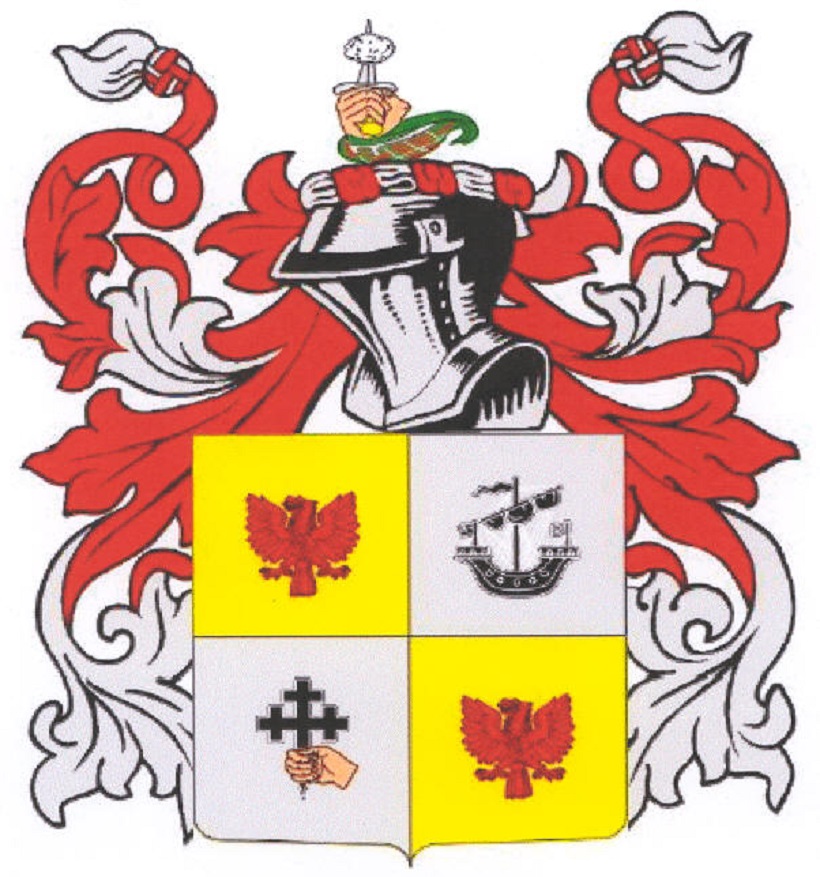
The above heraldry I believe is the correct one for the McAtee surname, although it was
invented long after our line came to America. This heraldry is also applicable to the
families McEntee and McGinty. They have a common origin. It took me years of work to
realize that this was the origin of the name. If you simply google the McAtee surname,
you're bound to be led off-track as I had been. I'll dig more into how I determined
this later in the document, but for now I'll say that a fundamental piece of information
is the McAtee Y-DNA. It points to a fairly specific part of the world that leads to the
right track.
In the beginning of the document on my Scott line, I noted that both my parents said their
families are Irish, Black Dutch, and Cherokee. Refer to the Scott document for my
analysis of the background of the latter two terms. My mom's side also had the tradition
of the mythical "full-blood" Cherokee great-grandmother. My mom's side did have a more
specific belief in 'Indian' ancestry, and my research confirms more on her side, but none
were actually Cherokee. And on my mom's side, the Black Dutch element seems to
exclusively come from Native Americans. Regardless, my mom's side doesn't have a
measurable amount of either element in me, her, or my grandmother, in our autosomal DNA
tests.
It also would've been more accurate if my mom had replaced the 'Irish' with 'English'.
But McAtee itself, which is the subject of this document, turns out to indeed be Irish.
I used to believe that the Mc- prefix of surnames was from Scotland and the O'- prefix
was Irish. It turns out that both are Gaelic in origin, where Mc- means "son of" and O'-
means "grandson of". I do believe that most Mc- surnamed people established the name in
Scotland, but they all originated in Ireland. There was no Scotland path in the story of
our McAtee line, and that's part of how it was difficult to determine. But I will
explain this later.
William Randolph McAtee 1891-1966
In the first phase of this story, we'll begin with individual men in the line, going
backward from my great-grandfather, for all of them that I know the names of. That
goes back to the 17th century. The second phase will cover what can be determined from
the surname and where it departed for America, and the Y-DNA which tells a tale that goes
all the way back, not just through written history, but to the very beginnings of
humanity. The final phase will cover the rest of the family tree of George Cornelius
McAtee, my great-great-grandfather, through all of his great-great-grandparents. Keep in
mind that most of them lived their lives before the Revolution, and information for the
most part becomes sketchy. I've had to rely on DNA to even identify our relation to many
of them.
Bill McAtee was my great-grandfather, born in Alma Arkansas in 1891. It was Bill who
established our association of our McAtees with the town of Mulberry, as he moved there
as an adult. He technically raised his family in the Vine Prairie township, which is
nearby to Mulberry. Bill was buried in Mulberry, as were my mom's parents. Bill and his
wife Belle had eleven children. The first nine, including my grandfather, were born in
Mulberry and Vine Prairie. But then one of the mysteries about Bill that I've not solved
happened, when he moved the family to Oklahoma about 1929/1930. They were enumerated in
Grady County in 1930. Billy Don was born there in 1931.
It seems that Bill intended to permanently leave Arkansas, but they returned before 1940.
I asked my mom about it, and I don't think she even knew they'd ever moved to Oklahoma.
It appears that bad timing was the reason for this being a temporary move, because the
Dust Bowl began at the same time, the great drought that struck the American plains.
Grady County is near to Oklahoma City, and it wasn't part of the devastated area, so I
don't think the Dust Bowl was the specific reason. There could've been effects of
destitute people migrating back eastward. This might've combined with the onset of the
Great Depression that made life difficult for our McAtees in Oklahoma, and Bill decided
to move back to Crawford County Arkansas. I can only guess. On top of this, their last
child Agnes was born with Down Syndrome in 1934. I'm not sure if that was in Oklahoma
or Arkansas. Bill registered to fight in both World Wars, though I don't think he
served in either, having many children in 1918 and being 51 years old in 1942.
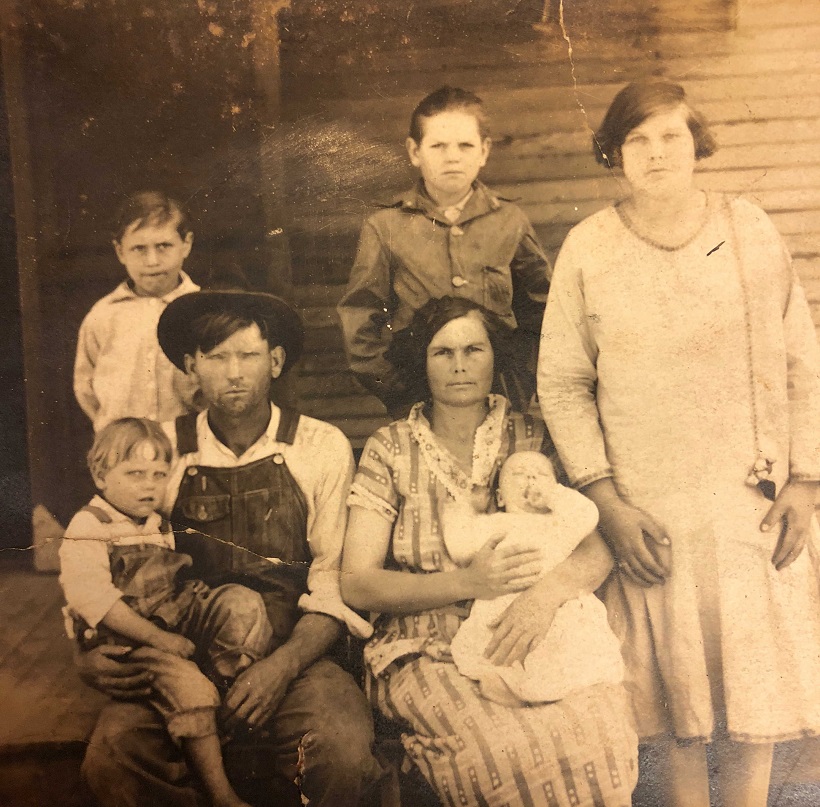
Bill and Belle McAtee and family - photo taken in 1934(?)
George Cornelius McAtee 1863-1945
Bill's father was George C McAtee, who was born in Polk County during the Civil War.
George brought the line to Crawford County, appearing as a farmhand in Alma in the 1880
census. George's mother and his stepfather (Silas Jacobs, whom he was raised by) had
moved from his birthplace to Sebastian County in the 1870s, and he followed them to
neighboring Crawford. I know that at least one of George's sisters was in Alma by 1900.
George raised his own family in Alma, and then moved to Fort Smith by 1908 when he was
45 years old. He evidently was a restless soul, and decided in the latter phase of his
life to pursue an urban existence. He lived until the age of 82 and had several
different residences and occupations in the city, including working for the Tucker Duck
& Rubber Company. I grew up in Fort Smith myself, and I never knew it was because of
George C. We didn't know he was buried just down the street from my cousin. I'd never
heard of George C before getting into genealogy.
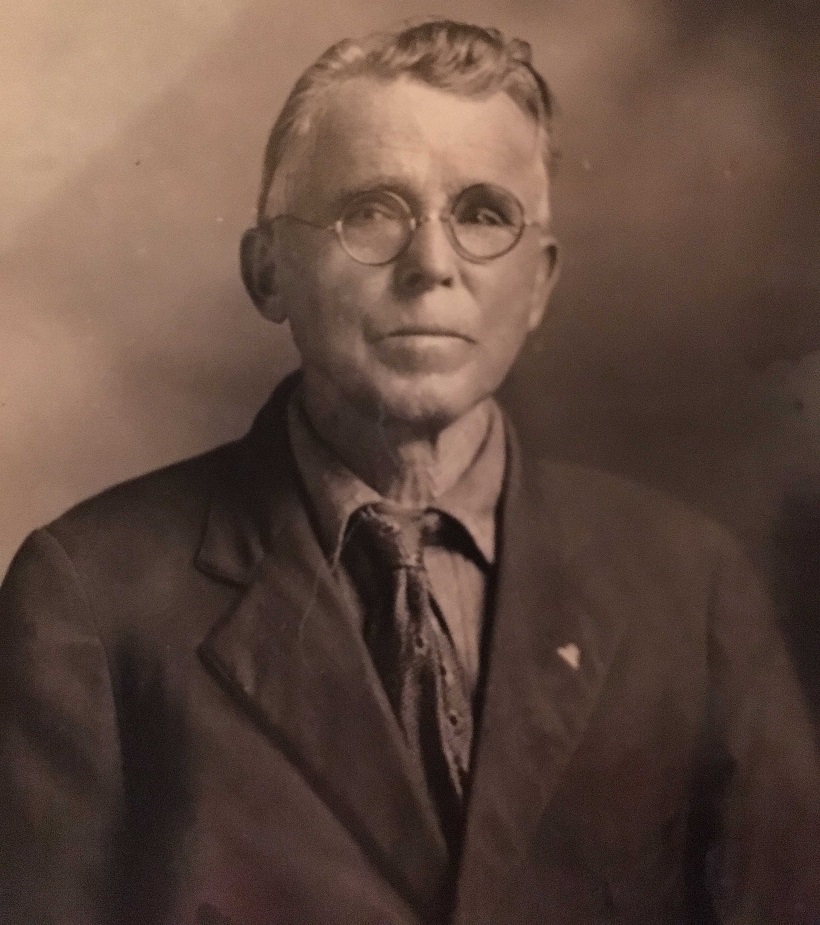
George Cornelius McAtee, a modern man a century ago
George died in 1945, and his daughter Nancy Freeman filled out the death certificate.
His wife had predeceased him, so Nancy was on her own to record the information. I've
seen the certificate myself in person at the Fort Smith public library, and the ladies
in the genealogy department told me its information is "the gospel". Well, it turns
out it's not, and it caused lots of confusion about the identity of George C's father.
Nancy recorded him as William McAtee. She put George C's birth year as 1862 in Logan
County Arkansas and his mother as Martha Hunter.
The only piece of new information of these that was accurate was the mother's maiden
name. Martha was Nancy's mother's name, not George C's. My earliest work as an actual
genealogist was finding out the truth about George C's origin. A cousin had hired
professionals to do it, and they made the mistake of attempting to prove the birth
certificate correct. Anyway, here's the true story. In 1860 Sulphur Spring township,
there were the households of brothers William and George B McAtee. William wed an
Elizabeth and had a son John 1 year old. George B wed a Sarah and had daughters Mary,
Harriet, and Arabella, who were 4, 2, and 1. William was assumed to be George C's
father and Elizabeth was assumed to be Elizabeth Hunter. If that were true, the impact
on our line would only be in the fathers' identity, because George C's true parents
were the brother and sister of William McAtee and Elizabeth Hunter.
We know this because of the 1870 census of Sulphur Spring, where Sarah has become the
wife of Silas Jacobs and has McAtee children Mary 14, Harriet 12, Arabella 10, William
9, and George B 7. I don't know what became of William's son John who should've been
11, but I suppose he was wherever his mother ended up. I don't know what her maiden
name was, but it wasn't Hunter. Aside from George's middle initial being wrong in the
1870 census, this obviously is the same family of Sarah, whom we know was Sarah Hunter
prior to marriage. Both William and George B died in the Civil War, which further
complicated sorting this out. But Elizabeth Hunter didn't wed William McAtee. She
bore William Cotnam children from 1856 to 1867.
It still amazes me that professional genealogists attempted to shoehorn her into
bearing William McAtee children during the same timeframe. The lesson learned is that
death certificates are decidedly NOT the 'gospel'. It makes sense, actually. Death
certificates are probably often filled out by a child of the deceased, who might not
know exactly when and where their parents were born. And if their grandfather died
before their father was even born, they're bound to not clearly know much at all about
their deceased parent's parents. Maybe even George C had thought his father's name
was William. He never knew his father. Elizabeth Cotnam was actually George C's aunt
and she moved to Sulphur Springs to live near her sister Sarah Jacobs (formerly McAtee)
and other relatives after William Cotnam died.
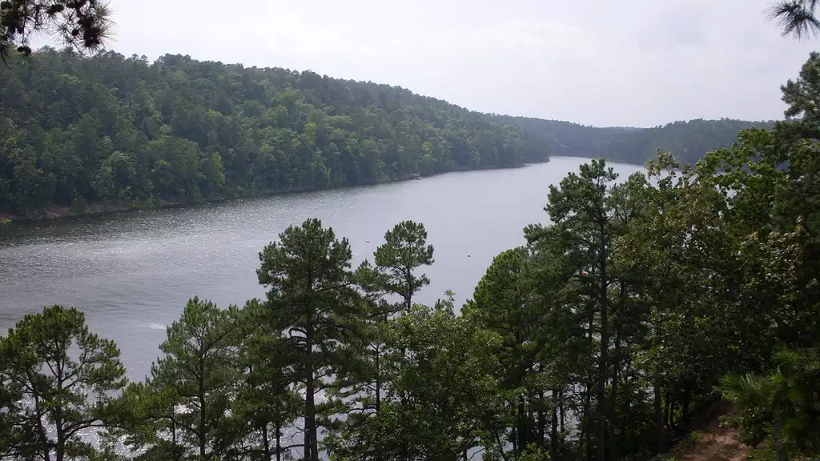
Modern Blue Ridge Campground on Dierks Lake
The last misinformation to correct regarding George C's death certificate is the county
where he was born, and the year. Sulphur Spring township no longer exists, but while it
was in Polk County when George C was born, the location was eventually in Howard County.
It was just north of the current Blue Ridge campground, south of the town of Umpire.
See the image above of the area, but note there was only a stream and no lake when
George was there. I have no idea why Nancy Freeman placed George's birth in Logan
County. Maybe George himself didn't know. And his birth year was 1863, not 1862. The
primary reason why I know 1863 is the correct year, is that George C was 7 and 17 in the
1870 and 1880 censuses, and his older brother William was 9 and 19. George was born in
January, so it was easy for Sarah to dictate his age accurately in a census. William's
being born in 1861 also makes it impossible for George to have been conceived the same
spring. You're probably wondering why it matters. The reason is that it's fundamental
to the circumstances at the time, which I will soon explain.
George B McAtee 1832-1863
George C's father was George B, born in 1832. I saw Sr's middle name claimed as Bason
on a genealogical site back in the day that no longer exists. There was a man named
George Bason who lived in the area where our George was born. George Bason was a
dentist, or some kind of doctor on the Red River in 1832. He wed the widow of Gabriel
Martin, another prominent man there. A Bason's Mill Creek is there today. I've heard
mixed tales of Bason's reputation, which casts doubt on anyone naming their son after
him. But I don't know who made that connection for our George B on that website.
George B always put his birthplace as Texas, which was true. Sort of. I'll explain
how George B's father came to the Red River in the next section. But for now, we'll
note that Texas didn't become a state until George B was six years old. The location
of his birth was in the state of Texas at the time of the 1850 and 1860 censuses, when
he declared it as such, but technically it had been in the Arkansas Territory in 1832.
Our McAtees are still in Arkansas today, for what will be at least 200 years by 2028.
Our McAtee bicentennial in that land will be before Arkansas's bicentennial.
George B didn't spend much time in the debated area, as the family moved to Hempstead
County Arkansas in 1834 which didn't become part of Texas in 1838. The family lived
northwest of the town of Washington, which was a significant place back then on the
Southwest Trail, the major road into Texas. I visited Washington in 2019, and I was
surprised to see a tavern there that opened the same year George B was born. They
serve a Reuben that we wondered if our ancestors also ate. What we didn't know was
the building had been moved to Washington from another location, but that still had
been within the stomping ground of our McAtees. They were a relatively prosperous
family, for reasons I will get to, and they surely had a wagon to make a 10 mile-or-so
journey for a restaurant dinner now and then.
I also noticed on my visit the portrait of a man named Royston on the wall in the
courthouse, who lived while our McAtees were there. He was Grandison Delaney Royston,
a lawyer. He first settled in Fayetteville Arkansas in 1832 before making his way to
Washington the same year. Washington was an even more major site than Little Rock at
that time, and the territory's justice system was centered there. Stephen F Austin
had been a lawyer in Washington in 1819. Royston became speaker of the house of the
Arkansas general assembly after his predecessor killed another representative on the
house floor! Royston was George B's father's attorney in 1834, when the Arkansas
Gazette was sued for publishing matters the court hadn't decided regarding George B's
mother's previous husband. I'll have a few more things to say about him, and you will
see the name Royston again. We aren't sure that a McAtee son was named after George
Bason, but one was definitely named after Royston.
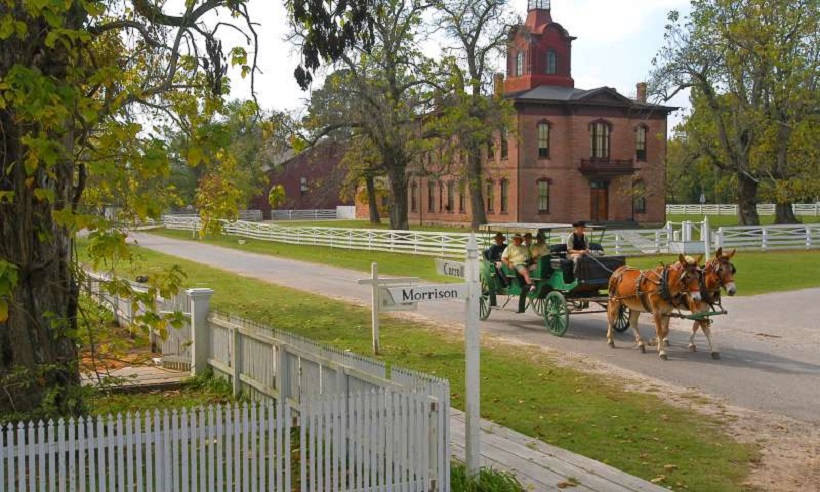
Washington Arkansas courthouse
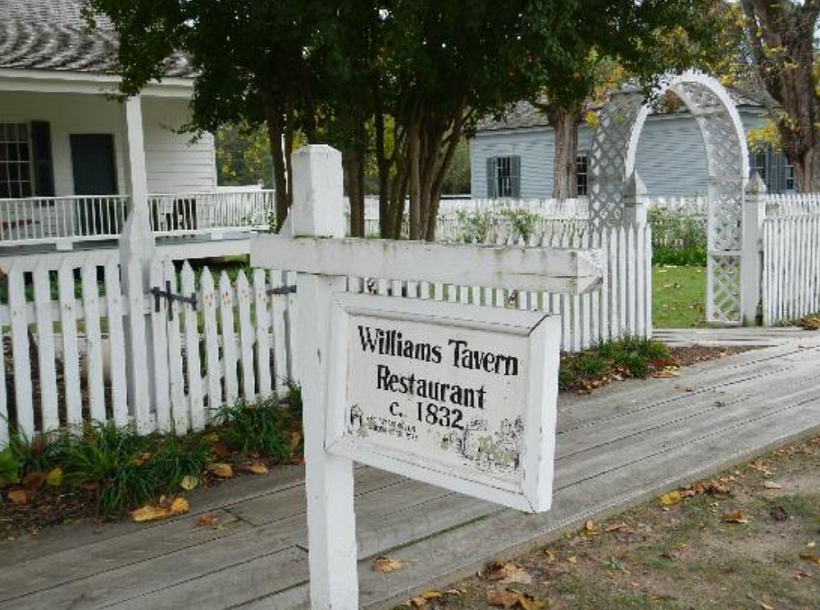
George B no doubt lived a formative part of his life near Washington Arkansas. I'll
give more information about it and the Hempstead County area in the next section. But
for now, our McAtees were in Sulphur Spring in 1850, moving there sometime after 1840.
Our McAtees were planters. They had considerable wealth, valued at $1M in today's
dollars, mostly no doubt in their 23 slaves. The planter status of our McAtees will
be addressed more as we go back in time, but we will now learn the full price our line
paid for it.
In 1861 the nation moved toward Civil War. George B was the eldest of three brothers,
being 29 then. William was 26 and Royston 24. All three signed up to join the
Confederate forces. George and William were enrolled in Dawson's 19th Infantry. In
March of the next year, all three were in northwest Arkansas for the Battle of Elkhorn
Tavern (called Pea Ridge by the Union). Royston was in the main Confederate force,
called the Army of the West. And although Dawson's 19th was sent there, they were so
poorly equipped (one in three were armed) that they were relegated to guard the main
force's baggage train. In that battle Royston, the youngest of the three brothers,
was killed. The Union took control of Missouri and northern Arkansas due to this
victory.
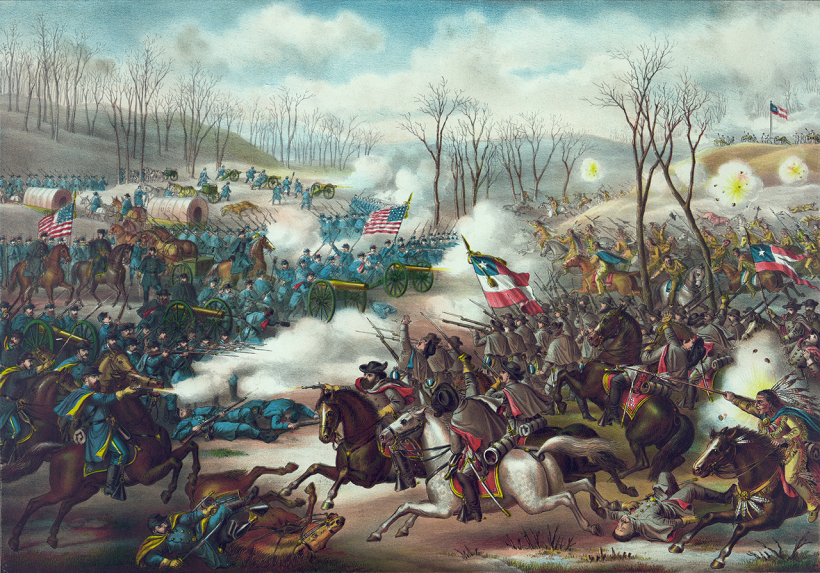
Depiction of the Battle of Pea Ridge
Presumably George B and William were aware that their brother was dead, when they were
immediately marched down through Fort Smith to the area of modern Kenefic Oklahoma,
the site of Fort McCullough. The fort was no more than earthworks, which Dawson's
19th was sent to help construct, under the direction of General Albert Pike. That was
a 160-mile march, if they made a straight line. 59 men died in the journey, probably
taking ill in March which can be cold in northwest Arkansas. The 19th was not only
lacking in arms, they were poorly equipped altogether. They weren't fed well nor
sufficiently protected from the elements. And it turned out that no battle would ever
occur at Fort McCullough.
The 19th was granted a much-needed furlough in April, and George B and William
returned to Sulphur Spring to tend to their families and crops. George B evidently
was well enough for George C to be conceived, which I believe happened at this time.
But their rest ended in July and George B and William were mustered in Little Rock for
training. The 19th was put into better shape there, and better equipped. William was
promoted to sergeant. From Little Rock they were sent to Arkansas Post in September,
site of Fort Hindman. Also with them was their cousin Thomas McAtee.
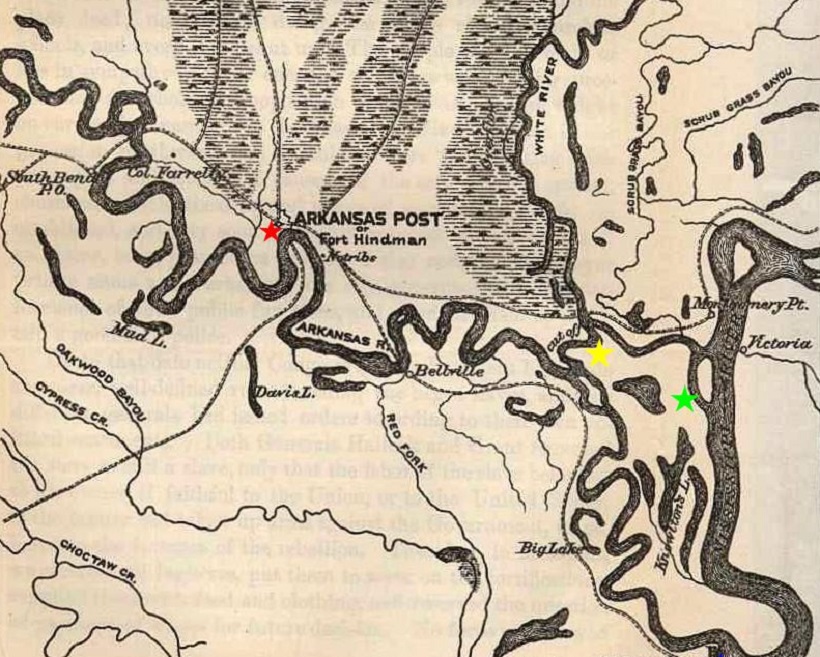
Arkansas Post had been established by the French as a trading post, long before the
Louisiana Purchase, before anything else was built by Europeans on the lower
Mississippi River. Fort Hindman was later constructed there, and had been the site of
a battle in the Revolutionary War. In the Civil War, the Confederacy sent soldiers
there in the hope of defending the Mississippi against advancing Union forces. But
what they could muster fell far short of accomplishing their goal.
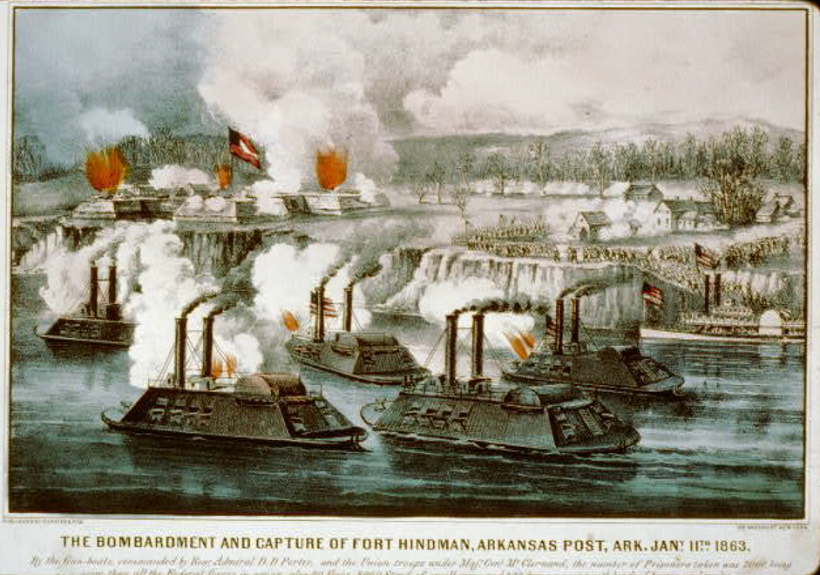
Fort Hindman quickly fell to gunboat bombardment and storming by Union troops. A
relative few were killed in the battle, and George and William and all of the
Confederates were taken prisoner. It turned out the battle was the easy part. Not
only was it January, but it was the coldest winter on record in many places. The
prisoners were put on steamboats and taken up the Mississippi. Ice floated in the
River. Dawson's 19th was better equipped than before, but as prisoners of war their
accomodations wouldn't be good. Somewhere on the way from Arkansas Post to Memphis,
back in Sulphur Springs George C McAtee was born. His father would never see him.
From Memphis the prisoners were shipped to St Louis. Many were ill and taken to
hospital there, and several were buried on its grounds. North of St Louis the
survivors were taken by train to their destination, Camp Douglas in Chicago. I
imagine cars better suited to transporting cattle. Chicago at that time was famous
for its poor sanitation, and Camp Douglas was even worse. Hundreds of the prisoners
died there. The train arrived on January 29th. George B passed away in the
hospital there of typhoid on February 25th. William died of dyptheria in the camp
on March 6th. Thomas McAtee also died. Less than half of Dawson's 19th survived
Camp Douglas. But amazingly, they went on to fight in battle after battle throughout
the South after being released.
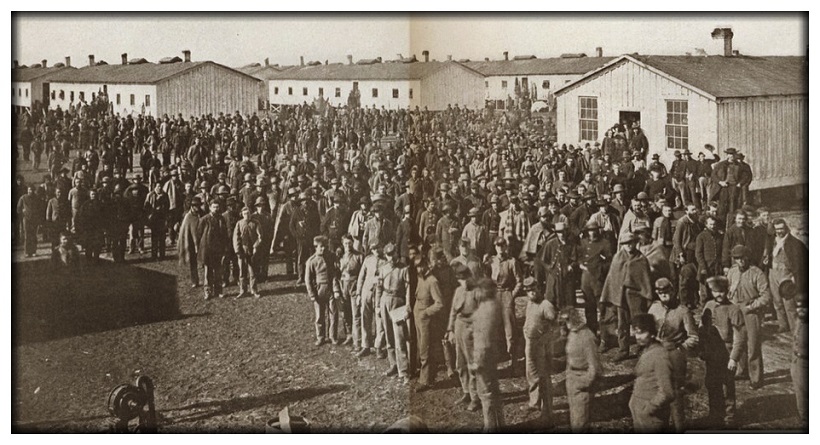
Camp Douglas, picture taken after our McAtees had perished
Today, the victims of Camp Douglas are commemorated by a monument called the
Confederates' Mound in Chicago. Of the two McAtee brothers, only William received
the dignity of being named. Thomas McAtee is named. But George B isn't listed. I
only know about his role in these events through a book published by Merrill Pence
on Dawson's 19th. Many of the dead of Camp Douglas were lost track of. William's
remains evidently were successfully transferred to the site of the memorial.
George had been buried at the hospital in the Camp, so it's not known if he was lost
track of there. But he performed the same service and shared the same fate.

Confederate Mound monument
William McAtee 1792-1856
George B's father was William McAtee, who was born in Maryland in 1792. William
brought our line to Arkansas. A direct trip all that way would've been impressive
in itself, at that time. But lots of significant things happened along the way.
William was born in Charles County and I believe he lived there until the age of 18.
What we know from records is that his father was in Charles County in 1800, and in
the 1810 census of Montgomery County. Charles is one of the southernmost counties of
Maryland, and Montgomery is to the north, on the other side of Washington DC. I
believe the family was in transit in 1810, because the US declared war on Britain
in 1812 and Maryland was directly involved, and I doubt very much that the family
would've decided to up and move during wartime. They left Maryland before 1812.
Researchers of our line weren't aware that Thomas McAtee born about 1765 was
William's father until recently. Professional genealogists were hired again to help
out, and this time they did. Prior to the recent research, all we knew was that
William appeared in New Orleans fighting under Andrew Jackson in the famous 1815
battle. What was then uncovered was that in Hempstead County Arkansas in 1840, a
Thomas McAtee appeared next to William in the census. From that nugget, the
researchers learned that Thomas was the son of a Thomas who went from Maryland to
Ohio, the connection made by the 1830 census there. It became obvious that the
younger Thomas was a brother of William, and we finally had solid evidence to
connect backward in our McAtee line. The McAtees of Charles County are a well-known
bunch, and we knew we descended from them, but now we have good certainty on
precisely what that line is. The Thomas McAtee who died at Camp Douglas was this
Thomas's son. They were in the Saline township of Hempstead in 1860.
So, getting back to William, his family was in Montgomery County Maryland on their
way to Scioto County Ohio in 1810. They settled in the Nile Township, which is on
the northern bank of the Ohio River just across from Kentucky. A creek that goes
into the Ohio River there is still called McAtee Run today, which is a certan marker of
exactly where they lived. McAtee Road connects to the Ohio River Scenic Byway where
it crosses McAtee Run. The bank of the river there was called McAtee Landing. Go
to Google Maps sometime and look at the street view there.
This I think is the point to raise the subject of just what kind of clan our McAtees
were. I've seen it claimed multiple times that they were Scotch-Irish like my
Scotts. Kentucky is a very Scotch-Irish state, so this move put them in contact
with that culture. But I seriously doubt that "hillbillies" would've been a good
definition for our McAtees before this point. Maryland was in its origin the
destination of Catholics to migrate to North America. Catholics weren't even
allowed in Virginia (boo Virginia!). I'll point out all the evidence for it as we
go back in time, but I'm 100% certain that our McAtees were Catholic in origin.
They were also boatmen, with waterways having been the primary means of transport in
Maryland. The Scotch-Irish were typically horsemen. The McAtee Landing mentioned
above was a landing place for boats. I'll be getting back to that.
The McAtees of Arkansas aren't Catholic, so it was a bit of a struggle for me to
finally give in to the mountain of evidence that they came from Catholics. But Ohio,
where William's father moved the family to, had no Catholic churches at all until
1843. No information has been uncovered to suggest
they had converted while in Maryland. They may have converted out of necessity when
leaving Maryland, but either way, the choices that William made going forward
indicate that he no longer practiced Catholicism. Or at least his children weren't
raised as Catholics. I know of two major cultural-transition men in my McAtee line,
and William was one of them. The other was his forefather Patrick who was the
patriarch of the line in America. Notice the Catholic name, Patrick. That's just
one piece of evidence.
So, William moved with his father to the Ohio side of the River from Kentucky,
between 1810 and 1812. Ohio was even more directly involved in the War of 1812 than
Maryland, which actually began in 1813. From what I've read, young men were so
eager to go fight the Brits again that not enough arms could be found to equip them.
The next thing we know solidly about William is he's in New Orleans in 1815 at the
age of 23. His life really is a mystery until 1828 when he appears in the Arkansas
Territory. He got married shortly thereafter, and our George B was born when
William was 40 years old. I've found no direct record to indicate what he'd been up
to in the intervening 17 years, a time when most men in my family tree back
then were settling down to make their own family.
The biggest question to consider is if William truly was a bachelor and had his
first child at the age of 40. I used to think this was impossible, and he must've
left another family somewhere when he came to Arkansas. Because no one apparently
came with him. But an important thing to consider is that women were few and far
between on the frontier. I believe that all of the Native American lines in my
ancestry (save the Tapps) occurred because of a lack of European women in the lives
of certain adventurous men, and they rustled themselves up a squaw, as it were.
Those situations occurred in the Colonial times. But William made such an
aggressive move westward that he put himself in a similar state in the early 19th
century. William's name is listed on an 1830 document that will be referenced again
later, where he was one of several men who were single and in their 30s. In 1828 in
Nacogdoches, as a point of reference, there were 600 men and 100 women. William wed
a widow in the Arkansas Territory, and it appears that he was very fortunate to find
her. Otherwise it seems he never would have married (and I wouldn't exist to write
this)! I find in doing genealogy that very many events could've gone only slightly
differently, and I wouldn't ever have been born. That's probably not the right way
to look at it, but it's freaky.
So, in this context, how and when did William come from Nile township Ohio to New
Orleans? He registered to fight from Alexandria Louisiana, an American settlement
going back to before the Louisiana Purchase, when it operated under Spanish rule.
Louisiana became a state in 1812. I used to assume that William decided to come to
New Orleans specifically because of the War, but now I don't think so. There are
tales of men who would later figure prominently in the Texas Revolution who went to
fight in New Orleans but arrived too late. It seems very unlikely that anyone in
Ohio could've gotten word early enough and been able to make such a long trip and
not end up tardy. I don't have firm evidence, but the circumstances suggest that
William was already in Alexandria when the call went out for soldiers to sign up and
serve under Andrew Jackson against the British.
Quite an industry already existed in New Orleans in 1810. In that year alone,
10,000 American men had taken keelboats and flatboats down the Mississippi River
network to New Orleans to deliver goods. The United States had acquired New Orleans
in 1803, and it was fundamental to commerce on the Mississippi and Ohio rivers,
a path that connected all the way to Pittsburgh Pennsylvania. This of course is the
reason why the British sought to seize New Orleans. Andrew Jackson had already
taken Pensacola and America was on the way to controlling all of the Gulf coast.
But getting back to William, these men who boated to New Orleans were collectively
called "Kaintucks". A crew of them would first construct a boat at some point along
the Mississippi or Ohio rivers, load it with their goods to deliver, and float it
down to New Orleans or Natchez Mississippi. They'd deliver the materials and take
their payment, then tear down the boats and sell the lumber. The majority were
famous for then taking the Natchez Trace on foot back to their origins, a month-long
trip. I imagine they had to go in groups to protect the profit they carried from
highway bandits. Some floated back up the rivers on steamboats. I expect that many
acquired a horse and rode back home. Then they'd do it all over again.
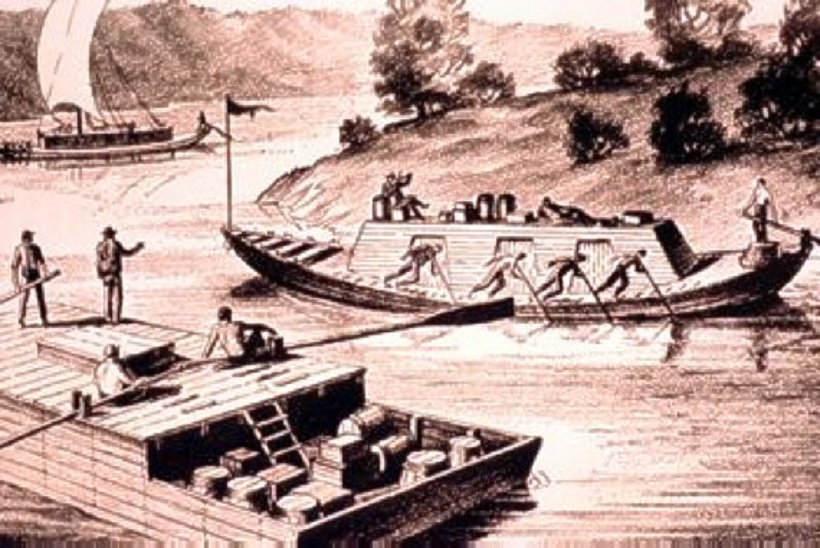
Example Kaintuck keelboat and flatboat
My belief is what William was up to, from the time his father settled on the Ohio
River around 1811, to William settling himself in 1828, was commerce. Remember that
our McAtees were already boatmen. It's nigh a certainty that William made his way
from Ohio to Louisiana via river, departing from McAtee Landing. He very well may
have constructed his own keelboats there. Or maybe just one. The first steamboat
to make the same trip was in 1811. As to whether William was specifically a
Kaintuck and made multiple round trips between New Orleans and Ohio, he seems to
have had more of an affinity for the Red River than the Mississippi. The points of
the documented record on the ends of the 17-year span in question are both on the
Red River. In 1815 he signed up for the Battle in Alexandria. In 1830 he signed
on for Wavell's Colony in the Arkansas Territory, at the Pecan Point settlement
which was on the Red River at the boundary today of the states of Oklahoma and
Texas.
William first appeared at Pecan Point on a document in 1828. In 1828 Texas was
Mexican territory and Oklahoma was being set aside for Native tribes. The exact
boundary between Mexico and the United States was uncertain, and the area of the Red
River, even to the west of the eventual bounds of the state of Arkansas, was claimed
as part of the Arkansas Territory then. I also know that William was already
friends with his future wife Harriett and her husband Claiborne Wright before 1828,
further supporting his being around the Red River as I will explain.
So, the way I believe the 17 years played out was William primarily shipped goods
down the Red River to New Orleans, or more likely Natchez. Our McAtees had been
prosperous in Maryland, but their wealth seems to have dried up around the time our
line left. As I understand it, all McAtees were out of Charles County by the early
19th century. William may have been driven primarily to bring wealth to his father
in Ohio. He therefore must've made regular return trips to McAtee Landing like a
Kaintuck, but I believe mixed in with primary business on the Red River. I expect
that he rarely spent much time in any one place, but if he did have a residence
other than his father's house in Ohio, it would've been at Alexandria. And he was
there in early 1815 to sign up and go to New Orleans to fight the British. The
British were supposed to win that conflict easily, their professional army against
the ragtag group of mostly Tennessee volunteers that Jackson cobbled together. But
it was an American blowout. It turned out that the Battle occurred after the War
was actually ended, but it took so long back then for news of the peace treaty to
travel that it didn't reach New Orleans in time. In fact, the American public at
large learned of the victory at New Orleans before they got news of the peace.
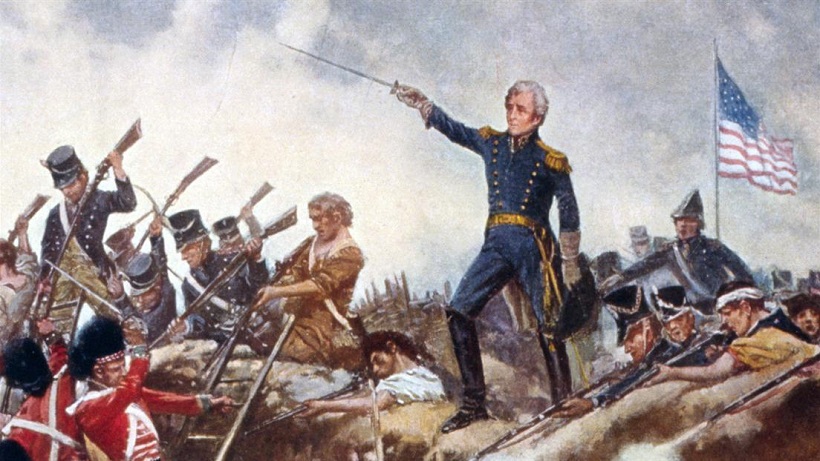
Naturally, the Louisiana Purchase spurred American settlement west of the
Mississippi. Spain claimed the border between Mexico and the United States was the
Red River. Jefferson believed it was farther south. But a treaty was signed in
1819 that formalized the Spanish claim. American settlers of the region weren't
pleased with it, and they hadn't waited to set up shop south of the Red River.
Stephen F Austin started his colony in 1821 far away in south Texas, and he got
permission from Spain to do it. I think technically that colony was the first
American one in Texas. But it wasn't the first in the territory that would become
Texas.
As mentioned previously, George B McAtee was born at a place called Pecan Point.
That was on the south side of the Red River, about 50 miles west of modern
Texarkana. This didn't occur until 1832, and William wasn't there until 1828. But
the site had been settled by a Caddoan tribe called the Natchitoch, from which the
names Nacogdoches, Natchtitoches, and Natchez come. A year after the Battle of New
Orleans, a man named Claiborne Wright built a 60-foot keelboat at his home in
Carthage Tennessee and floated his family down the Cumberland River to the Ohio to
the Mississippi to the Red River, and landed at Pecan Point, a six-month journey.
It's highly likely that he would've crossed paths with William on the Red River,
particularly at Alexandria. Wright wasn't the first man to settle at Pecan Point,
but only a small few preceded him. This was a wild time, the area a haunt of
outlaws and Indian traders and scattered settlers squatting on a piece of land.
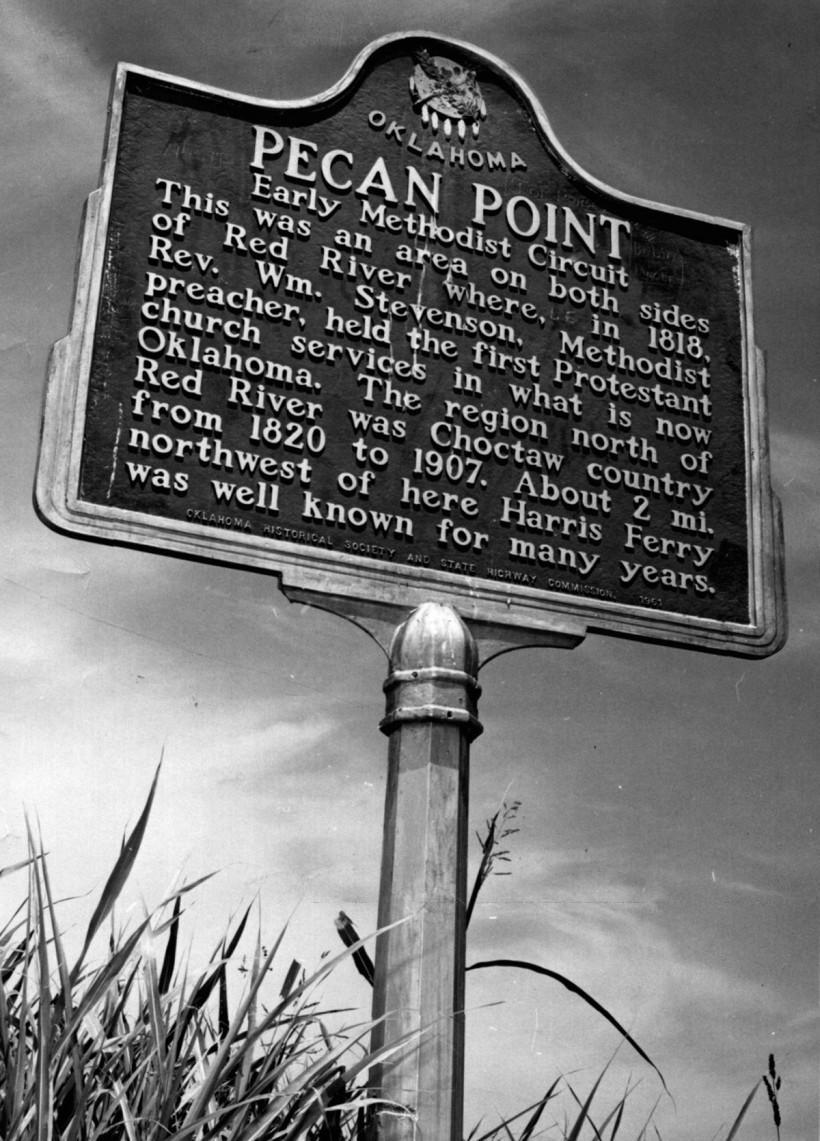
It's my belief that William had been on the Red River from as early as 1811 and
certainly by 1814. Men who fought in the Battle of New Orleans are known to have
gone to the Pecan Point area directly afterward to evaluate it for settlement, and
that probably was the source of those first few American settlers. I expect that
William had been that far to the northwest on the River for trade at the least.
George B grew up in Washington Arkansas, which was the hub of the settlement area
around the Great Bend of the Red River, with Pecan Point being one of the farther
west parts. William certainly would've been familiar with Washington before 1820,
where he ended up settling down.
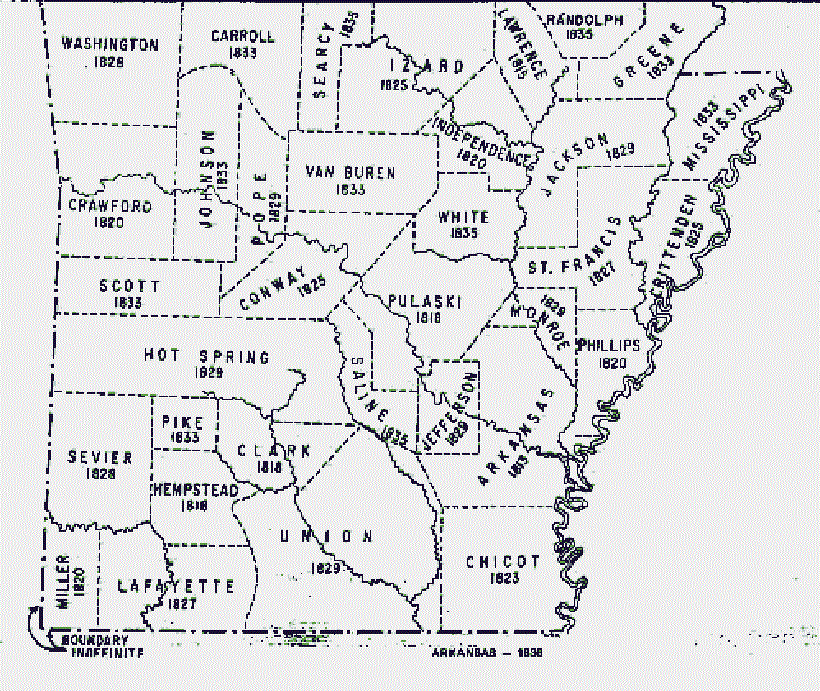
Arkansas in 1836
At the bending point of the River nearest Washington was the town of Fulton, named
after Robert Fulton. He invented a steamboat called the Nautilus in 1800, the
namesake of Jules Verne's ship in his book 20,000 Leagues Under the Sea. The town
Fulton was a three-way junction. Going to the northeast was the Southwest Trail,
connecting to Washington and Little Rock and up to Missouri and the Midwest. It
was the primary path that early settlers of Texas followed. Also at the junction
was the Red River and ferries that took people across. On the other side began
the Trammell Trace, a path cuth by Nicholas Trammell for smuggling horses into
Louisiana. He was an infamous character of the time, but the pathways he made for
his own illicit trade were travelled by all early entrants to Texas. William
McAtee may also have made use of it, if he wasn't always on a boat on the Red
River. Even before Pecan Point was settled by Americans, it was a locus of trade.
Native tribes exchanged pelts and furs for guns and other goods. Pecan Point was
a major buffalo and wild horse crossing.
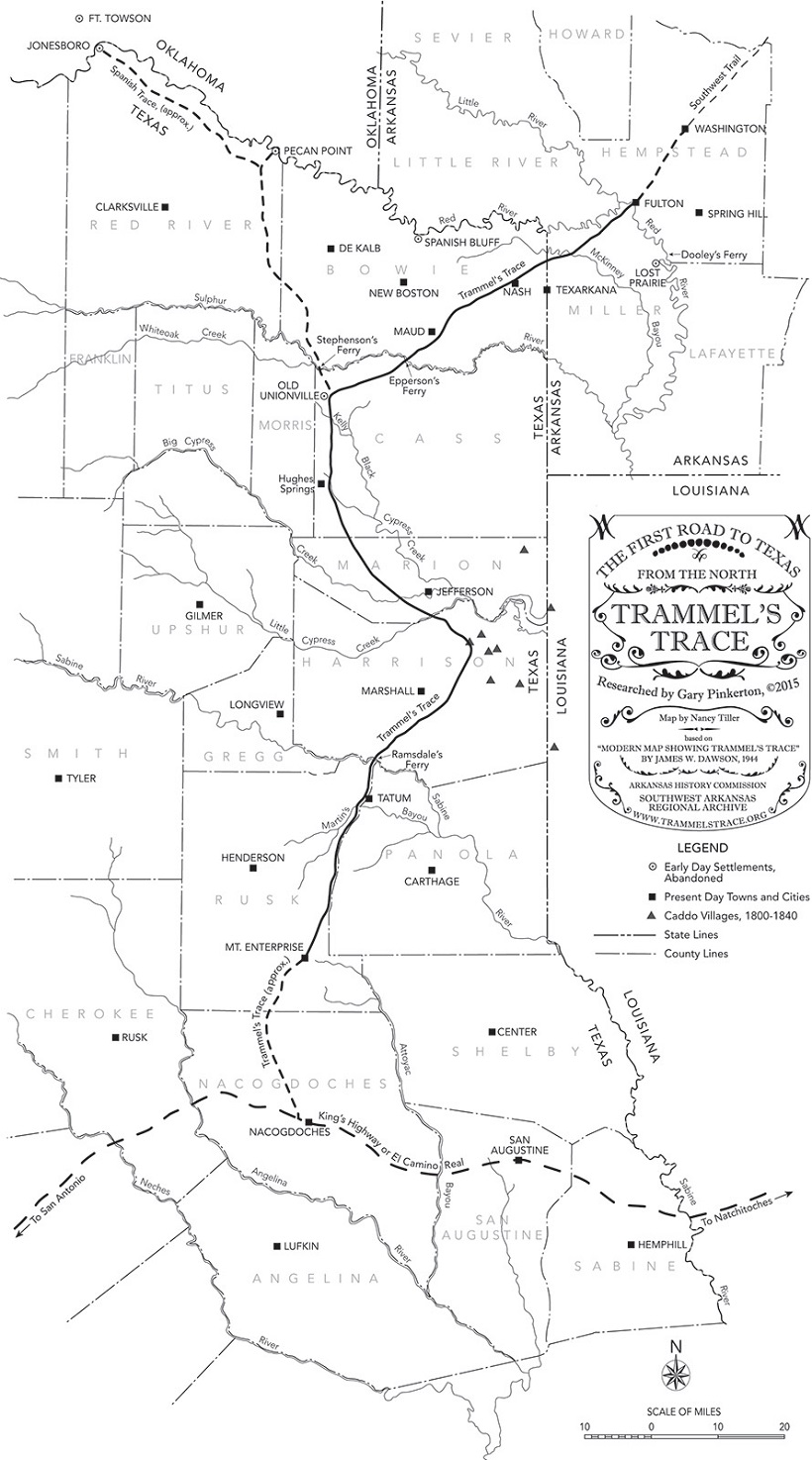
Trammel Trace map, with modern county and state boundaries
The Arkansas Territory was carved out of the Missouri Territory in 1819, and by
1820 the initial counties of Arkansas were defined. Note that the notch in the
southwest corner that would end up being part of Texas was in Miller County
Arkansas in 1820. The Arkansas map above represents the situation in 1836, prior
to Texas joining the Union. And before that, the Oklahoma Territory was part of
Arkansas, and Miller County extended farther west and south than the eventual
bounds of the state of Arkansas. See the next two maps.
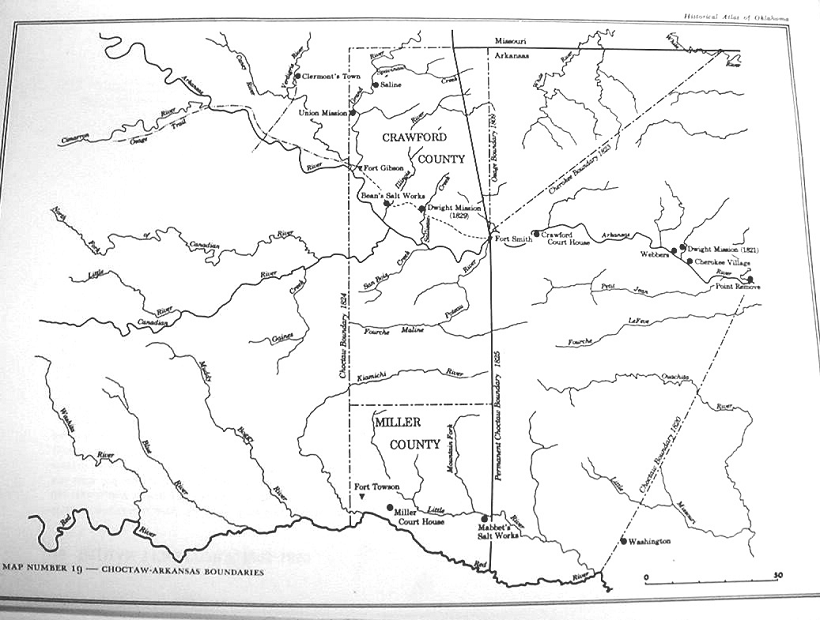
Portion of Miller County Arkansas Territory within the bounds of future Oklahoma
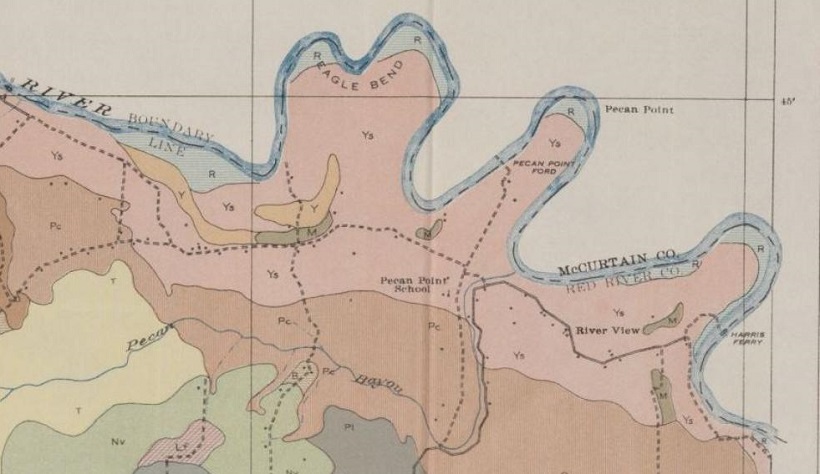
Pecan Point was to the west of the final western extent of Arkansas, and south of
the Red River. That spot of course eventually became part of Texas. It was
settled six years before Austin's Colony was established. Many famous alums of
the Alamo and framers of the Declaration of Independence of Texas came from old
Miller County. And it was a rocky ride along the way. Claiborne Wright moved to
the north side of the Red River some time after first landing. When Miller
County was formed, Wright's house actually served as its first county seat. The
portion of Miller County west of the eventual western extent of Arkansas and
north of the Red River, was granted to the Choctaw in 1821 who were being driven
out of Mississippi. The US government actually torched the crops and homes of
settlers on that side of the River. The settlers' reaction was to burn down
their courthouse themselves, and they removed to the south side, which was then
definitively part of Mexico. Miller residents signed a petition that year to
protest this allocation of the territory. Claiborne Wright signed it. By 1824,
Choctaw, Chickasaw, and Cherokee refugees began making settlements on the north
side of the River. William didn't live there yet, but I expect he was often
passing through. Wright had quite the struggle when he first arrived, to get
his family to Pecan Point because of what was called the Great Raft, an enormous
natural logjam on the River above Natchitoches. It's possible that William
engaged in trade by land between Natchitoches and Pecan Point, on the Trammell
Trace, rather than navigating the Raft. But William was acquainted with Wright,
and being a trader in the area makes sense as the explanation how.
In 1823 Claiborne Wright wed Harriet Brown after his first wife died, and they
had two sons. Harriet was in the area because her father moved her family there
as early as Wright had. In 1825 another petition was made by Miller County
American residents for all of the area around the Red River to be theirs, and
William wasn't listed with them. But in 1828 William was documented as being at
Pecan Point, as was Claiborne Wright. Settlers of the area were caught between
two nations. The settlers were determined to not lose their property on the Red
River, even if it meant becoming part of Mexico. Signees in 1830 to join
Wavell's Colony swore an oath of allegiance to Mexico. The Colony was an
attempt at an Empresario grant like Austin's, and it occupied the northeast
corner of Texas formed by the Great Bend in the Red River.
The signees were slaveholders and Mexico didn't approve of the practice, and
the settlers didn't
want to become Catholic (I suppose William himself wouldn't have minded on that
point) or speak Spanish instead of English. There was so much American
migration to northeast Texas at the time that Mexico revoked the budding colony
and the settlers reverted to a state of limbo, betrayed by their native United
States when the territory they settled on north of the River was given over to
the Choctaw. The Miller County courthouse was rebuilt at Clarksville on the
south side of the River in 1831, when the Wavell Colony was attempted. William
is on a list of people who applied for recompense for property lost north of
the Red River, as he also moved in February 1830. Presumably it was Claiborne
Wright's former property.
Some have claimed that Claiborne Wright died at the Alamo, the same man I've
described. But actually a younger man of the same name, who was no doubt
related to the elder, was the one who perished in 1836. I know that Harriett's
husband died in 1829, because William McAtee wed her afterward and DNA supports
her and her ancestors being my ancestors. Plus, the name Cornelius was passed
to our George C from Cornelius Brown, Harriett's father. And not to mention
all that proof, but William is documented as handling Wright's estate after his
death, including hiring Grandison Royston as his lawyer as mentioned previously,
and paying Wright's back taxes. Wright didn't die naturally. He was stabbed
in the stomach while attempting to break up a fight in a Jonesboro tavern.

William's wedding to Harriet brings us to the story of his wealth. Our McAtees
of Maryland had been considerable slaveholders. But It's obvious that our line
were no longer planters when they left Maryland. I'd previously envisioned
William as being relatively poor when he came to New Orleans, but if he did
engage in trade from the age of 19 to 36, he probably not only delivered wealth
to his father but increased his own status. It may be that such status put him
in a position to wed Harriett. Claiborne Wright was a planter. He was related
to the Claibornes who were significant figures in Virginia and Louisiana. I
don't think I've found evidence of how many slaves Harriett had in 1830, but
she and William had 23 in 1840. Therefore the McAtee family planter status was
restored by William wedding Harriett.
I've wondered previously if William was involved in the nexus of events at the
juncture of Arkansas, Louisiana, and Texas in his time. There were the
infamous Long Expeditions, where James Long led attempts to capture Texas for
the United States beginning in 1819. Long eventually was taken prisoner to
Mexico City and died there of an apparent assassination. Involved in those
adventures was the pirate Jean Lafitte. I don't believe that William was
involved, or there would be some documentation of it. But it's possible.
All that said, let's consider James Long's wife, the former Jane Wilkinson.
She was born in Charles County Maryland, the same as William. Unlike William,
her family still had wealth when she relocated to Natchez Mississippi in 1811.
But given that the McAtees and Wilkinsons had been wealthy families in the
same county, I've looked into connections between them, and I'm aware of at
least one wedding between a Mildred McAtee and Bennett Wilkinson. I'm not
entirely sure of Bennett's relation to Jane Long, probably her uncle, but
William and Jane were related regardless. Mildred was William's aunt.
I wondered for a time if William made a family at Natchez and somehow left them
to go to Pecan Point, because there are McAtees in Natchez even today. But I
think it more likely they went there with the Wilkinsons about the same time
that William went to Ohio. It's not impossible that William traveled to
Natches with them in 1811. A cousin of Jane Long's moved from Natchez to
Alexandria in 1819, whom I expect William was acquainted with. Jane herself
moved to Alexandria in 1823 after James Long was killed.
If William didn't travel to Natchez in company with Jane, it's possible that he
visited her there. He certainly would've been there, probably many times. She
lived amongst the elite of the city, on a bluff above the more seedy area where
merchant business was conducted. I'm not sure if William would've fit in the
"high" society. I don't think there's much to conclude from them being
acquainted, but another prominent Texian called Ben Milam knew her and I
believe pursued her romantically after James Long's death. William certainly
knew Milam. It was Milam who acted as agent for Arthur Wavell in attempting to
form the latter's colony that William signed up for.
In fact, William arrived at Pecan Point the same time that Milam did. Milam
came from Mexico City after arranging the Colony, and I doubt that William was
with him at that point. But I also doubt that William arriving at Pecan Point
the same year was a complete coincidence. I expect that Milam traveled by ship
to New Orleans and then went up the Red River, and I would guess that William
met him and learned about the Colony and decided to join. Maybe Milam
contracted William for a ride. Milam died at Bexar in 1835 and is celebrated
in Texas as a hero. There's a statue of him in San Antonio. Jane Long herself
was called the Mother of Texas. It was claimed that her daughter by James Long
was the first American child born in the future state. But it isn't true. Her
daughter was probably the first born of high society there, which gets you
written into books.
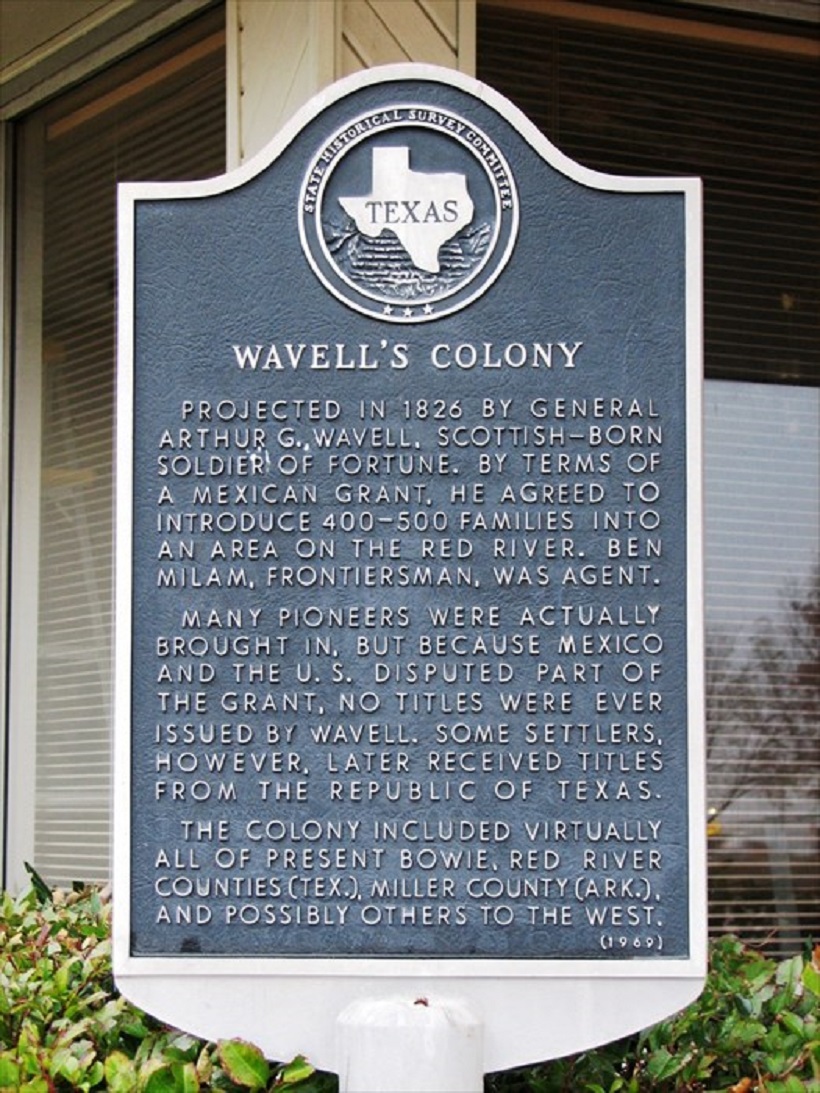
So, William McAtee certainly rubbed shoulders with the Texians, the men who
would lead the Texas Revolution, resulting in Texas eventually becoming part of
the United States. But he didn't join them. James Long and Ben Milam were
around the same age as William. He could've gone south with Milam. But he wed
Harriet after Claiborne Wright's death, and they began to make their own family.
George B was born the same year as the first battle of the Revolution. They
might've stayed where they were and become Texans, but they had connections to
the north. Harriet's father had property in Hempstead County, which was sold
in 1824 when he died. It's possible that they moved there to property they
already owned. There were also Indian raids around Pecan Point that probably
didn't occur up the well-trodden Southwest Trail, although it was a relatively
rough track back then with tree stumps only cut low enough for wagon axles to
pass over.
But what I'm sure was a factor in the move was the 1834 Pre-emption Act, which
granted land claims in Arkansas to anyone occupying and cultivating land in
1833. I expect that William and Harriet learned of this and decided to take
advantage of it, and that's how they became Arkansans rather than Texans. They
are documented as living in Hempstead County in 1834. Nicholas Trammell also
took advantage of this offer, claiming land east of Washington. There he
operated a tavern and gambling hall. Washington even had organized horse
racing. I have a record of William and Harriett receiving a 312-acre grant in
1834, which may have been in recompense for the forced evacuation of Pecan
Point from north of the river.
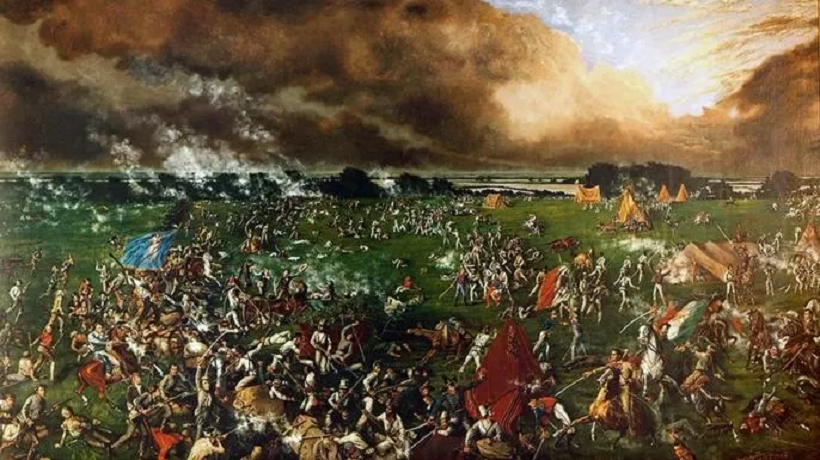
Depiction of the Battle of San Jacinto
As mentioned before, Stephen F Austin practiced law for a time at Washington
Arkansas. He speculated in land in Little Rock just as it was named the
capital of the territory, before moving into south Texas to become an
Empresario with his colony under the Mexican government. Collin McKinney had
been a resident of Pecan Point, and he was the eldest signer of the Texas
Declaration of Independence. James Bowie, Sam Houston, and Davy Crockett
passed through Washington Arkansas "on their way to the Alamo" and made plans
at a tavern there. Washington in 1834 was filled with people keen for a
Revolution in Texas. The Bowie knife is said to have been the creation of
a blacksmith in Washington. A Bowie knife was used by Grandison Royston's
predecessor in the previously mentioned murder on the Arkansas state house
floor. Bowie participated in the Long Expedition, as did Ben Milam. Bowie
intended to fight at New Orleans in 1815 but arrived late. Sam Houston
passed through Pecan Point in 1832, the year of George B's birth there.
David Burnet was a trader in Natchitoches from 1817 to 1819, and then moved
to Ohio. Our William McAtee came that close to being a Texian himself, and
he probably met all of these men.
Returning to the subject of McAtee Catholicism, regardless if William ever
formally converted, there certainly was no Catholic church in southwestern
Arkansas at that time. Cases are known to have occurred even in Maryland
where a McAtee man wed a Protestant woman, and the children were raised
Protestant. I expect that was the case with Harriet and William's children.
When Texas became a state, the area of old Miller County Arkansas south of
the Red River was claimed by it and this was finalized in 1845. In 1850 the
US Congress finally approved land grant awards to the men who fought at New
Orleans. William got an initial 40 acres and sold it. He was in the
process of acquiring another 120 acres when he died in 1856, making the
claim null and void. Harriett probably sold property to her sons, and she
had 9 slaves left in 1860. She lived to see her world entirely destroyed in
the Civil War, losing all three of her sons by William. She died in 1866 as
the post-War terrors began to ravage the South for decades to come.
Thomas McAtee 1716-1777 and 1765-1835
I group two generations together here, because although we know with good
certainty that this is the path back to our McAtee patriarch Patrick, I
don't know much about these two. And they happened to have the same name.
The form of the family name settled as McAtee in their time, due to the
McAtee men becoming educated. Patrick himself was illiterate, evidenced
by his marking his will with an 'X' and not a signature. The form of the
name is essential in determining where it originates from, and I will
certainly be getting back to that subject in later sections of this document.
I'll call the elder Thomas I and the younger Thomas II. Thomas II was
William's father, and naturally Thomas I was Thomas II's father. Both
were born in Charles County Maryland. As was covered in the previous
section, there was a Thomas III and Thomas IV who aren't in our line,
thus I don't use the terms junior and senior for the elder two. On that
subject, confusion has been caused in determining our line of succession
because censuses listed Thomas McAtee Sr and Thomas McAtee Jr, and that
didn't mean one was the father of the other. It only meant that
one was older than the other.
Our connection to Thomas II was proved through Thomas III, as described in
the previous section. In the 1800 census of Charles County Maryland,
Thomas II appears as Jr and the senior in the same district was his uncle.
Movement away from Port Tobacco, where Patrick began the family, indicates
growing distance from the line of succession. In 1800 Thomas II had 4
slaves. As was addressed before, I believe that Thomas II's residence in
Montgomery County in 1810 was temporary. That census didn't list slaves,
but I expect Thomas II didn't have any at that point. He probably sold all
his possessions in Charles County and set out for a new place where his
sons had better prospects. He's next found in Scioto County Ohio in 1820
and 1830. As I will explain in the coming sections, Thomas II's move was
the end of almost 140 years for our McAtee line in Maryland.
In 1791, one year before William was born, the new capital of the nation
was founded in Washington DC, about 20 miles north of Port Tobacco. The
first session of Congress there was held in 1800. As discussed previously
in this document, I believe Thomas II left Maryland before the War of 1812.
As Montgomery County was on the other side of DC from where they began, I
expect that they passed right through the young capital on the way. Thomas
I was long since deceased then, and our line had left by 1814, but our
McAtee kin were still Marylanders during the Battle of Baltimore. The
Star Spangled Banner was inspired by that event, but it didn't become the
national anthem until the 20th century.
The Capital was left undefended and evacuated and was burned by the British.
With them were former slaves. Francis Scott Key wrote a verse of the
Anthem with harsh language about them that we don't recite anymore. Look
it up if you don't believe me. Looking backward to the Revolutionary War,
many McAtees fought in it, but our line was out of alignment with it, as it
were. Thomas I was about 60 years old at the onset and Thomas II was 11.
Baltimore served as the temporary Capital then for a time, and no battles
occured within Maryland.

Depiction of the Star Spangled Banner raised in the Battle of Baltimore
What helps to prove that Thomas I was Thomas II's father is that Charles
County tax lists identify our Thomas Jr as the son of Thomas and another
Thomas Jr as the son of John. John was the eldest son of Edmund. Thomas I
was a younger son of Edmund. One of the interesting things about Thomas II
and what made determining the identity of his father more difficult, is you
will notice he was born when Thomas I was about 50 years old. But it's
true. Thomas I and his wife Ann had seven daughters before finally
producing Thomas II as a son. They had one more child after him, who was
an eighth daughter. One of those daughters was Mildred mentioned before
who wed Bennett Wilkinson. Also, Thomas I's will lists Thomas II as being
underage when it was written, a year before Thomas I died. As for Thomas
I's birth year, a tax list was made for Charles County in 1733 and Thomas I
didn't appear on it while his father Edmund did, indicating that Thomas I
was not yet of age. 1716 is further supported as correct based on the
estimation of his age in a later legal document. The last thing I know
about Thomas I was that he already moved away from Port Tobacco before
Thomas II moved farther away, yet both were still within Charles County then.
I'll take an opportunity here to recognize Mary Louise Donnelly, who may
have been the earliest genealogist to document the McAtees of Charles County.
She didn't descend from them, but she had ancestors from there that knew the
McAtees. The first thing I'll note about her work is she was Catholic and
categorically described the McAtees as having been Catholic. So, that's a
significant piece of evidence on that question. Some later genealogists
bash her for making mistakes, but I think she did a great job overall and I
appreciate her work. She got tripped up on Thomas II, thinking him born in
1734, and she didn't know what became of him. But we only got that
straightened out recently. She noted in her book where she wrote about the
McAtees that she understood Sr and Jr in documents back then didn't
necessarily mean father and son, but still all the repeated names and
diverging McAtee lines made for a difficult task to tease out who was who.
Edmund McAtee 1684-1764
Thomas I was the son of Edmund McAtee, who was the eldest son of Patrick,
our McAtee patriarch. I believe that Edmund was born in the Port Tobacco
district of Charles County Maryland, which I will explain in Patrick's
section. They lived on a plantation called Pomfret, which was part of
Panguya Manor, among several neighboring properties. Our McAtees didn't
give it that name, and the location is still called Pomfret today. I
believe Pomfret itself had a single house on it when Patrick acquired it,
and as his sons became adults they built additional houses for their own
families and the plots were apportioned out as inheritances. They might've
also purchased surrounding lots, as I will describe.
At various points in time, rent rolls listed the land Edmund living on as
Ralph's Folly and Aquinsick. Aquinsick has a Wikipedia page actually, but
it makes no mention of McAtees. It came from a Native American name, maybe
of a village that had been on the site. Wikipedia says the name was given
to a 1000-acre escheat in 1704, and the article is about a house built
there in the 1780s. James McAtee, another son of Patrick, lived at Nothing
Venture Nothing Have. When Edmund's eldest son John came of age, his
property was listed as "remainder". All of these were probably part of
Panguya Manor. When Patrick died, Edmund was said to live in the northwest
part, which I believe was Pomfret and the original building, said to be at
the head of Port Tobacco River. Today it's called Port Tobacco Creek and
it may have changed course over the years. It was reduced from a river to
a creek by silting that ran off from the cultivation of tobacco. Today
Pomfret is a pleasant neighborhood of gentle hills and nice houses. It
might have been the nature of tobacco planting consuming the soil that
drove our McAtees out of Port Tobacco and out of the tobacco business.
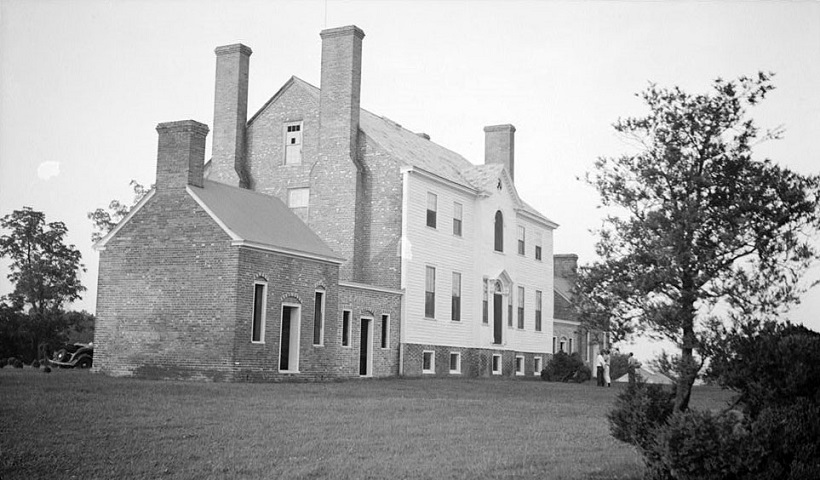
Dr Gustavus Brown House at Rose Hill, very likely a relative of McAtees, built while our line was there
In 1763, St Joseph's Catholic Church was built on Clements land adjacent
to the McAtees. The two clans were intermarried, as will be seen later in
this document. This is another piece of evidence that our McAtees were
Catholic. When Edmund died the next year, Thomas I was said to live on his
own plantation. That was probably in the neighboring Pomonkey district of
Charles County, where he was elsewhere documented living. Edmund willed to
his eldest son John the plantation on which the latter already lived, which
I believe was Pomfret, the same place Edmund inherited from Patrick. John
named the property McAtee's Luck. I've heard claims that John acquired
that plantation himself and named it himself, but I'm 100% certain that
Patrick named it and it wasn't until his grandson John that the name was
officially recorded, or changed from what it had been officially called
before. In the next section I will explain how it received that title, and
give more detail about just how much Luck the McAtees came into.
Patrick "Pat" McAtee 1652-1717
To tell the story of Patrick in full context I go back to 1623, three
decades before his birth. In that year, the Englishman George Calvert was
granted an estate in County Longford Ireland and he was made Baron Baltimore.
The word Baltimore is from Gaelic, meaning "townland of the big house".
Patrick's birth has been placed in Longford by other researchers. I don't
know what the origin of that information was, but it makes sense because
Patrick would come to have a fairly close association with George Calvert's
son Charles as soon as Patrick landed in Maryland. The fact that Patrick
went to Maryland is further evidence that he was Catholic, as that was the
destination for Catholics in North America, especially in the early period
that he went. Baltimore Manor was in the Drumlish diocese of Longford, which
is a few miles north of the town of Longford.
George Calvert received a charter to found a Catholic colony, and the result
was Maryland. It was Catholic because the Calverts were Catholic. But
George himself never went there. His son Leonard, the second Lord Baltimore,
established St Mary's City in 1633. The next year, Port Tobacco Village was
founded, 24 years before Charles County was established, within which it
stood. Pomfret came to be in the Port Tobacco district, but at the far
northern end away from the Village itself. Charles County was named by the
way after Charles Calvert who was born in 1637, not King Charles who granted
the charter for Maryland. Charles Calvert followed his brother Leonard to St
Mary's City and would become the third Lord Baltimore. St Mary's was the
original capital of Maryland, and Charles Calvert was its governor from 1661
to 1675 and 1679 to 1684. As a relevant side note, in 1664 slavery was made
legal in Maryland.
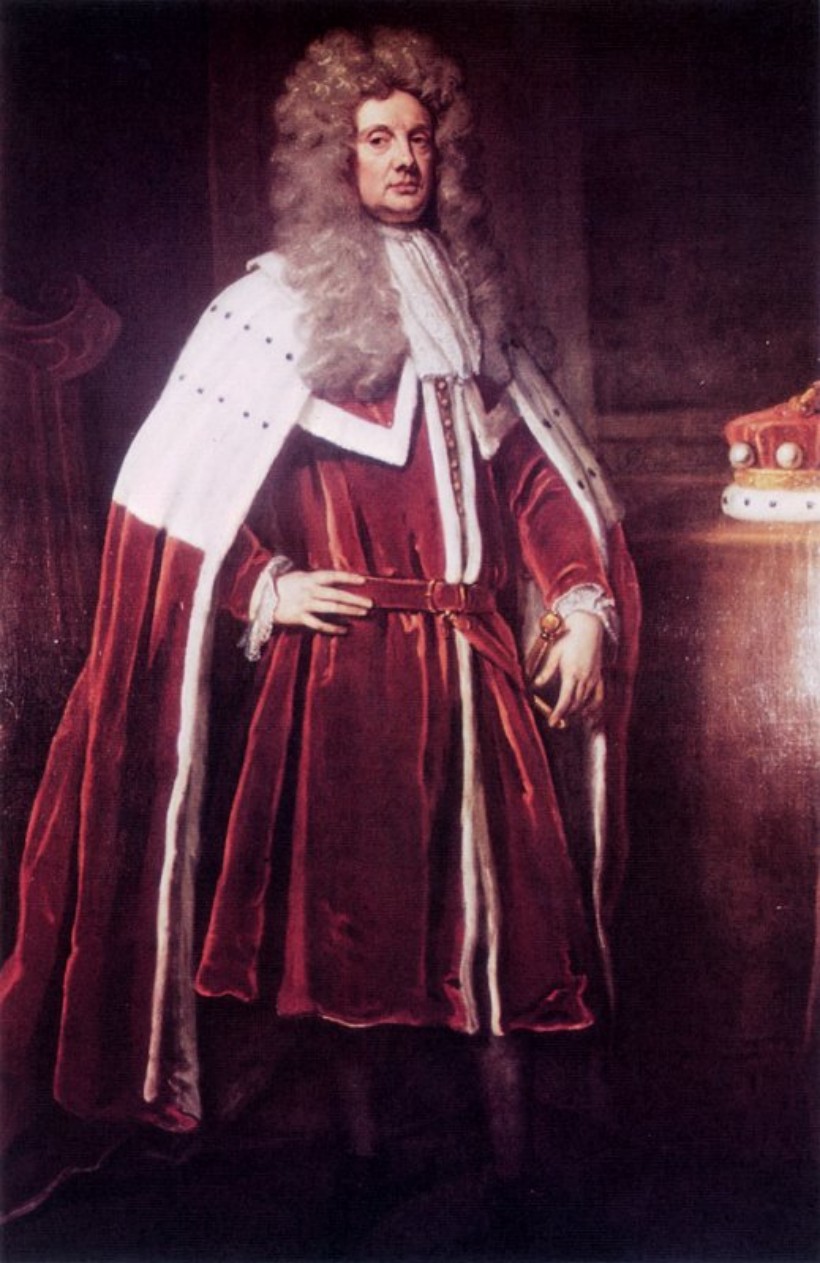
Charles Calvert, third Lord Baltimore
Patrick's birth year is estimated from his being declared "around 60" years
old in a 1712 document. Aside from the claim that he was born in Longford,
it's been assumed that he was born in Ireland partly from the record of a
ship that landed at St Mary's in 1674. The ship was called the Batchelor
and it came from Bristol England. It was known to make stops at Dublin,
Wexford, Waterford, and Cork on the way to Maryland. If Patrick came from
Longford, he probably boarded at Dublin. We know about that voyage because
a manifest was saved, which was rare in the 17th century. On board were a
Patrick, Edmund, and Henry Magee, and a Robert Mackahee.
Some debate whether that Patrick was ours. I've seen a claim that
researchers of a Patrick Magee of Virginia want that landing as theirs. But
it makes precisely zero sense that someone whose destination was Virginia
would've landed at St Mary's City Maryland. The transport also had
conditions that make no sense for a Virginia destination, which I'll get to.
I personally am completely confident that our Patrick did land at St Marys
in 1674 on that ship, and I will explain my understanding of the manifest
and its consequences. If the manifest raises doubt that Patrick even came
from Ireland, I have other good evidence that he did, which I will get to in
a later section of this document.
The primary problem with the manifest is the form of Magee used for Patrick
and two other men. And was Robert Mackahee related? Magee has been used by
some researchers (me included) to decide that McGhie was the correct form of
our line's origin. As I stated before, the form of the name is critical in
tracing backward across the Atlantic. But I'll address that later also. My
belief, in the full context of all I've learned about McAtee, is the person
who filled out the manifest was an Englishman with no expertise in Irish and
Scottish names, or at least Scottish and Irish brogues. Aside from Magee,
he spelled Montgomery as Magumery, and Copeland as Koapland, to give two of
many examples.

Replica of the Dove, smaller of Arc and Dove that brought Leonard Calvert to Maryland
The replica is docked at the reconstructed St Mary's City today
The Batchelor was probably larger, but this certainly would bear a resemblance
Many have taken the 1674 manifest as the basis for telling the tale of Three
Brothers sailing to Maryland from Ireland. Louise Donnelly investigated
Edmund's line and found that none of his sons had surviving sons to carry on
the name. But his name definitely seems to add credence to him being
related to our Patrick, because both men named their first sons after the
other. As for Henry, I have no idea. I have seen the name Henry in
Donnelly's trees of McAtee lines outside of mine, but he doesn't seem to
have been closely related to Patrick or Edmund. Given the naming
inaccuracies of the manifest, Henry might truly have been a McGhie, or even
a Magee of England. As for Mackahee, my guess is Robert actually was a
McGahee.
The Batchelor carried 90 men, all of them bound to indentured servitude to
pay for their passage to the New World. As part of the ship documentation,
it was noted that Edmund was indentured to Robert Ridgely and Patrick to
Charles Calvert himself. Maryland overall was not majority Catholic,
especially Charles County, but St Mary's City was almost completely
Catholic. I take this as one of the more significant pieces of evidence
that Patrick was Catholic, even if it depends on him having been on the
Batchelor. I definitely believe he was. I've seen that Patrick's son James
claimed his father landed in 1684, but I think that was in error.
Eventually the capital of Maryland was moved to Annapolis, and St Mary's
City gradually dwindled until it was abandoned. But it's been reconstructed
and I visited in 2019. It was a long drive to get there from La Plata, the
current seat of Charles County, even today. At the time of Patrick's
arrival, transport in the area was predominantly by boat. I read that it
wasn't until the 1880s that waterways ceased to be the main thoroughfares.
As was written about in William's section, our McAtees being watermen set
the course for his life, for the establishment of McAtee's Landing in Ohio,
and for our line ending up in Arkansas.
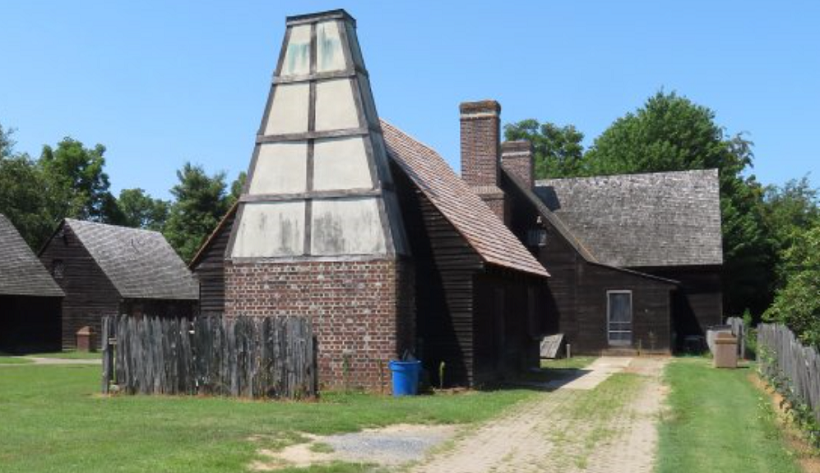
Reconstructed St Mary's
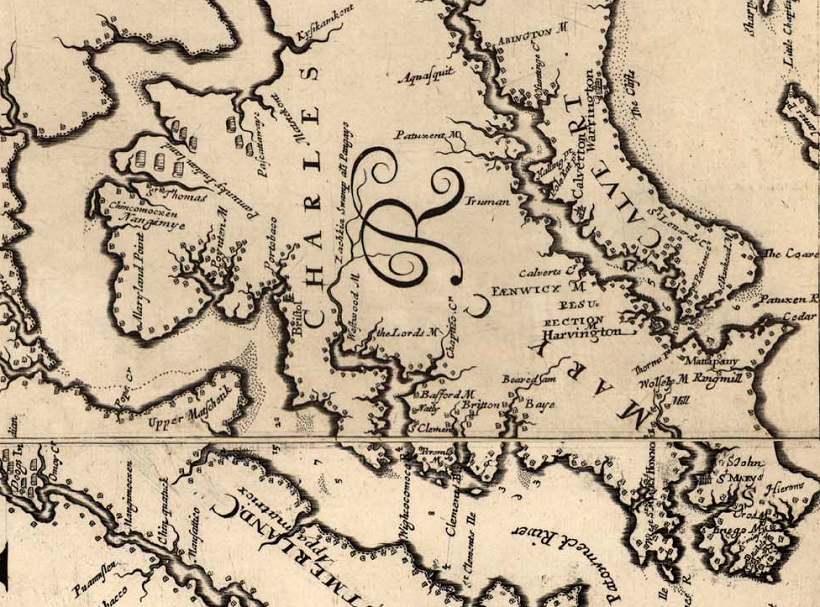
Maryland in 1670
In 1675, Maryland and Virginia were at war with the Susquehannock tribe. I
don't believe that Patrick was brought to Maryland as a mercenary, but he
might've been involved in the conflict. In 1676, the first statehouse of
Maryland was built at St Mary's. It's been reconstructed, and I read that
the original was built in brick the same way. Patrick probably was involved
in its erection. An interesting bookend to our McAtee line ending up in
Mulberry Arkansas is there was a Great Mulberry Tree in St Mary's that lived
until 1876. The tree is said to have been to Maryland what Plymouth Rock was to the
Pilgrims. Unfortunately it was effectively hacked to death on the
centennial anniversary of American Independence by people collecting pieces
of wood from it to carve souvenirs out of. Crude nails were found embedded
deep within the trunk, where Charles Calvert is believed to have posted
notices for the early community.
A "family marriage record" for Patrick and his wife Rosamond is returned by
ancestry.com's databases as having them wed in 1665. Some have taken this
to mean they were married in Ireland and maybe even Edmund was born there,
and then they came to America. But this is impossible. Patrick would've
been about 13 years old in 1665. There's no point in even addressing other
problems with that date. Records confirm that Patrick's wife was Rosamond,
so the claim isn't totally unfounded. Louise Donnelly claimed 1679 was the
correct year. Edmund was born in 1684, and I've seen claims that he had
older sisters. If Patrick was able to wed in 1679, his indenture period
was fairly short.
Donnelly found that a man named James Browne began leasing 150 acres at
Pomfret in 1679, and I believe she understood that to have been arranged
for Patrick and Rosamond, because Rosamond was Browne's daughter and it was
a wedding gift. I do believe myself that our Rosamond was Browne's
daughter, but I think he leased Pomfret for himself beginning in 1679 and
it didn't become Patrick's until 1698 when the total acreage had grown to
500 and had significant value. It definitely was a plantation worked by
many slaves owned by Browne.
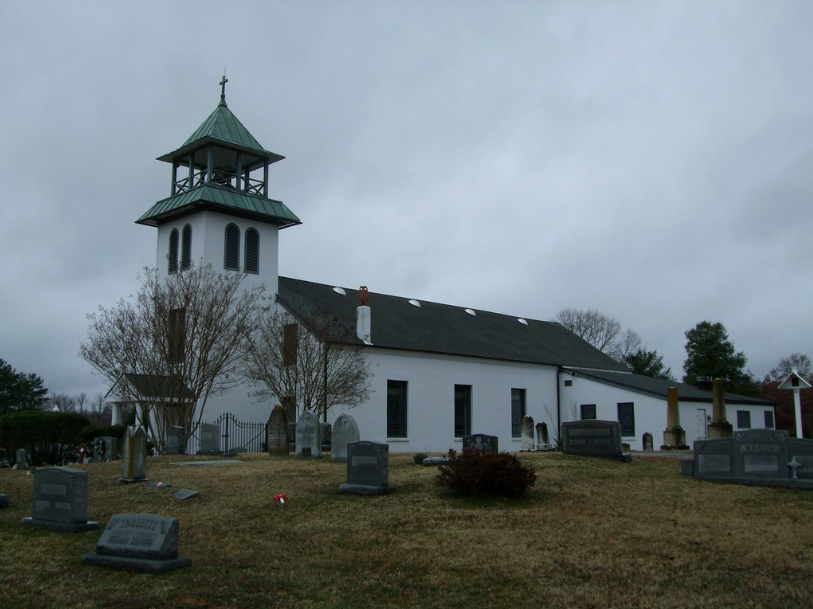
St Joseph's Church at Pomfret, today
Many have expressed doubt that Rosamond was Browne's daughter. For
example, Ann Smithson, James Browne's wife, is argued to have been too
young to be Rosamond's mother. But that's based on 1652 as Rosamond's birth
year, and I doubt very much that is accurate. Smithson was born in 1638.
Rosamond was married in 1684, so she probably was born closer to 1660. Even
assuming that Patrick wasn't on the Batchelor and wasn't an indentured
servant, he couldn't have had the wealth to buy his own plantation. It's a
fact that he was illiterate, evidenced by his own will. And Pomfret came to
be called McAtee's Luck for a reason. I understand the desire by
researchers to have point-to-point documentation such that any theory is
irrefutable, but in a case like this it shows that such insistence can lead
to broken logic. The story here simply makes sense. But if records are
uncovered to prove me wrong, I'll be happy to correct this account.
What's also a fact is that Patrick McAtee (spelling of the name at the time
took varying forms like Machetee and Magitee, because Patrick couldn't spell
it himself) was made the sole legatee and executor for James and Ann Browne.
What happened was James wrote in his will that he left Pomfret to Ann, which
included two lots and a house, and she could only pass it to another man if
she wed him and he was a "Roman Catholic". This proof that Browne was
Catholic is another major piece of evidence that Patrick was as well, that
he wed their daughter. Browne died in 1697. But Ann took ill the next year
without having written her own will, and it's said that she left everything
to Rosamond and Patrick on her deathbed. I don't know if it actually
happened that dramatically, but Patrick became the official inheritor. I
also know that a "pestilence" was documented striking Charles County in
those years, and is suspected of doing in the Brownes.
While Donnelly believed that Patrick and Rosamond lived at Pomfret from 1679,
I suspect they resided on property adjacent to it. The custom at the time
was for indents to receive 50 acres of land, a full suit of clothes, and
implements to establish their own farm once the contract was completed. The
practice was ended in 1684. Patrick may have gotten 50 acres next to the
Brownes, or they may have informally gifted him part of their property,
beginning around 1679, depending probably on whether he wed Rosamond first or
after he moved there. I believe that Edmund was born there. His brother
James was born in 1695 and that was claimed as being in the Port Tobacco
district, before Patrick's inheritance.
Another part of James Browne's will was he left two large parcels of land to
his daughter Mary: 500 acres on the Potomac and 500 on the Patuxent.
Donnelly argues that Mary was one and the same as Rosamond. That might seem
flaky, though she produced evidence that Patrick's wife was called both Mary
and Rosamond. I tend to believe it's true, based on how the value of
Patrick's property increased after 1698. I'll have some info on that a bit
later. On a similar note, I'm not sure now where the information came from,
but I had taken notes that Patrick's property was both at the head of Port
Tobacco Creek and the Wicocomico River. The latter may have come from
Donnelly, but it's definitely wrong. The Wicocomico comes nowhere near to
Pomfret. It might be that Patrick inherited a separate lot on the Wicocomico,
or there was some other mistake.
As was stated before, Charles County was never a majority Catholic population.
British politics in the colonial times were dominated by religious battles.
George Calvert grew up with an affinity for Catholics, and later in his life
he converted to become one. Catholics came to be persecuted even in Maryland.
After the Glorious Revolition in Britain in 1689, control of the colony was
taken away from the Calverts. It came to the point that Charles's grandson
Charles became Anglican in 1713 to regain the Governorship.
Patrick McAtee died in February 1717. Donnelly recorded valuations of the
family's property at the times that wills were written. I didn't save the
exact numbers, and I haven't learned how to convert them to current dollars,
but the beginning value was significant. By 1717, it had increased about
fivefold. I believe that was due to Rosamond truly inheriting the two
500-acre parcels, and maybe even a third on Wicocomico, and they were sold.
The value of their property doubled again between 1717 and 1764 when Edmund
died. It went up another 25% by 1776 when Thomas I died. I suppose most of
that wealth passed down the eldest son line which diverged from mine at John
son of Edmund, and that in my line divided down with each generation until
they left Maryland altogether. I also never saw that the name McAtee's Luck
was used after John declared it. It may be that the name was attached to
the original house itself, and it was already 80 years old when Edmund died.
Maybe once it was rebuilt, the name passed away with it. But it makes for a
nice story.
You may have noticed that Patrick became a planter by wedding a Browne, and
William in our line later regained planter status by wedding a Brown. Were
Rosamond Browne and Harriet Brown related? I can't trace Harriet's line
earlier than 1700, and Rosamond was born about 1660. I don't know anything
about James Browne. Brown/Browne was a very common surname with origin
points all over the British isles, so I tend to doubt they were related at
all. Just a very interesting coincidence.
McAtee in Ireland
I've seen claims since I began working on McAtee ancestry that our line is
Scotch-Irish, and I used to believe it. My autosomal DNA says that I'm
mostly English, and the majority of my paternal lines came through Virginia.
The predominant 18th century pattern was a Scotch/Welsh/German man came over
to seek his fortune, and most of the available women were English. So, it
was easy to see Patrick McAtee falling into the same pattern. As I said
before, the Crawford County Arkansas McAtees are not Catholic. But we have
seen conversions happen. Witness George Calvert becoming Catholic and his
great-grandson Charles then becoming Anglican. As I've reviewed in this
narrative, our McAtees were around Catholics all the time in Maryland. I
didn't deny they were Catholic themselves out of any prejudice. Since
people killed each other over their religion, I just didn't think conversion
was much of a thing. But the evidence of our McAtee path through history
unavoidably points to them beginning as Catholic. It would take some
miraculous mental gymnastics to still hold onto the notion that they were
always Protestant fish swimming in Catholic waters. In fact, they no doubt
endured considerable persecution going back to Henry VIII, like all
Catholics in the British Isles.
So, working with them being Catholic, that obviously has a big impact on how
they got to Ireland. It means they were always in Ireland, going back to
where there were no Scottish people to try to distinguish from Irish people.
I don't know what the chances are that a Catholic could've gotten by very
well in Scotland in the 16th century, but I think they're pretty small. And
other fundamental evidence supports the conclusion that our
McAtees weren't Scottish at all.
Firstly, let's tackle the form of the name McAtee. As I understand it,
there are McAtees in Scotland, but they're rare. The McAtees in Ireland
aren't any better-documented nor particularly numerous. From the beginning
of my research it seemed that the form of the name had shifted upon
immigration to America, and if I could figure out what it shifted from, that
would unlock our origins. But as I realized in my Scott line, the brick
wall that rises at the point of emigration isn't due to some fire in the
Irish Troubles that burned key records. It's due to people who weren't
wealthy not being important enough to have their names written down at all.
And odds are, if your ancestor came to America, it wasn't because they were
rich and trying to get richer. The vast majority were paupers looking for
opportunity to improve their lot.
So, the first piece of evidence that sends you down a McAtee-origin rabbit
hole is the ship Batchelor's manifest which had Patrick's name as Magee.
For a long time I wondered how an entire syllable was either dropped from
the name in the manifest, or added in Maryland. Even for a name spoken with
a thick brogue, anyone can recognize the number of syllables in it. At
least one McAtee researcher identified that Magee came from the Scottish
name McGhie, and they found a Patrick Herman McGhie in Scotland who might've
been our Patrick's father. I adopted it myself back in the day, and that
rabbit hole takes you back to McEth and Shakespearean Scottish kings. But
what I finally had to resign myself to, is that not everyone descends from a
famous person, and the farther you look back in time, the most likely truth
is your actual forefathers will fade into anonymity. Once you accept that,
you're freed to not be distracted by things such as an Englishman adapting
your illiterate ancestor's name to the closest name he was familiar with, or
just badly mispelling it. McAtee does not come from Magee or McGhie. Magee
doesn't come from McAtee, either. Bear with me and I'll explain.
The next McAtee-origin rabbit hole I plunged into was closer to the mark,
but still wrong. I got ahold of Ulster muster rolls, still hopeful that I
could find Patrick himself and his father. I didn't. But what inescapably
caught my eye was the name McAteer - only one letter different from McAtee,
and the same number of syllables. To top it off, the list had been
organized with a column for the "correct" form of the name. McAteer had
been written down as it was heard by the recorder. The "correct" form was
McIntyre. Eureka! I thought. McAtee had come from McIntyre. I pictured
Patrick pronouncing his name as mac-en-teea, swallowing the 'r', which was
actually McIntyre but could be written down as McAtee (if that rolled 'r'
at the end was missed). I still felt as certain about it as standing on
quicksand, but it seemed more solid ground than McGhie.
From what I've learned, modern McIntyres aren't entirely certain of their
origin themselves. One thing that seems accurate is it's Scottish, which
in itself doesn't rule it out for our McAtees, but I doubt there are many
McIntyres in Scotland who are Catholic. You also have the confusing
situation of McIntyres who came to the Irish plantations. I don't think
anything about McIntyre matters either way in determining the origin of
McAtee though, which I'll explain. One of the first things I learned when
researching McIntyre is that McAteer isn't just a spelling variant of it.
McAteer is a separate clan in Ireland. McAteers claim that McIntyres came
from McAteers who settled in Scotland. McIntyres don't agree. But that
argument is pointless in my opinion, because hardly anybody used surnames at the time
this transfer was supposed to have happened. Still, I think it's obvious
that the names McAteer and McIntyre have a common origin. And that leads
me to how I split the hair to separate McAtee from them. Or to go back to
the previous metaphor, how I found the way out of that rabbit hole back to
the fresh air. And the carrot.
Before I ever got into genealogy, one day back in the '90s there was this
guy who set up shop in the mall, back when that was a thing, back when we
had to actually leave the house to buy stuff. That guy was selling framed
heraldry printouts of Scottish clans. Hey, I might be Scottish, I thought,
so I had a look. I bought one for McAtee. I think my parents still have
it hung on the wall. It had a little blurb about the history of the clan.
It said McAtee means "son of a scholar". Huh, pretty neat, I thought.
Well, it turns out that whoever wrote those blurbs knew a thing or two
about Gaelic, and that translation is the McAtee Rosetta Stone. But
before realizing that, as I got older and more cynical, I dismissed this
cute claim of being descended from scholars. That was just a ploy to give
people a false sense of pride, I told myself.
Nowadays you can find that translation on websites, even Wikipedia. And
in my further researching McIntyre and McAteer, something interesting
happened. They come from Gaelic Mhac an t'Saoir, which means "son of a
carpenter/wright/artificer". T'Saoir is a generic term for someone who
crafts stuff. McAtee comes from Gaelic Mhac an t'Saoi, "son of a
scholar/wise man". Don't ask me if the pronunciation of the Gaelic bore
any resemblance to mac-a-tee. I have no idea. But the first thing I had
to come to grips with is, just that one letter difference, the 'r' on the
end, makes for a considerably different meaning. I'd been trying to
prove that the 'r' on the end could've been dropped. But it turns out
that's a big change. I realized that maybe McAtee has always been
distinct from McAteer, and illiteracy and clerical error didn't lose the
distinction over time after all.

Now, let's look back to the difference between McIntyre and McAteer. It's
essentially just the dropping of the 'n'. Vowel shifting is easy. That's
what accents do. And that's when the name McEntee smacked me in the
forehead. This is a specifically Irish name that's an alternate form of
McAtee, or McAtee is an alternate form of it. Like McIntyre and McAteer,
the essential difference is having the 'n' or not. That particular
missing letter doesn't change the meaning.
Most material on McAtee and McIntyre and McAteer websites is clouded in
uncertainty, with competing claims of who descends from whom, if "son of a
carpenter" was related to Jesus, or some guy who cut off his finger to
plug a hole in a boat. But I found a site on McEntee that clears it up,
for us at least. McEntee was a sept of clan Duffy in a certain over-kingdom
of Medeival Ireland called Airgialla (Oriel in English). McEntee is as
different from McAteer as carpenter is from scholar. McAtee shares a common
origin with McEntee (and McGinty). There was only a dropped 'n' between
McAtee and McEntee. Note also that the term scholar has a religious origin.
Literacy was introduced into Ireland via Catholicism. The Irish are very
proud of their religious history, and our McAtees fit right in.
DNA evidence also happens to align perfectly with Oriel and Catholicism.
I'll get to that in detail later, as we can trace the general path our
McAtees took, even before the line came to Ireland. I'm not a male
descendant of Patrick McAtee, but that doesn't mean I can't know what his
Y-DNA haplogroup is. Other male descendants of him have tested as R-M222,
specifically terminal SNP S588. The R-M222 haplogroup comes from one man
who lived in Ireland in the vicinity of modern Derry. When exactly that
man lived was first estimated to correlate with a king called Niall of the
Nine Hostages, about 1500 years ago, but recent research suggests he may
have lived several millenia earlier. If our McAtees had proven to be
Scotch-Irish, I would've assumed our line was one of those Irish clans
that migrated across the sea to become Scots. But being Catholic at the
point of immigration, and the name aligning with a specific medieval area
of Ireland, I'm certain that at least since R-M222 originated our line
made their homes in the island of Ireland, and specifically in the Ulster
region. Also note that neither McIntyre nor McAteer nor McGhie are R-M222.
McAtee in Irish History
My Scott line was one that adopted the surname and didn't descend
genetically from clan gentry. And most people didn't have surnames at all
until the 16th century. I'm not sure about the McAtees though. I don't
know if all of them are R-M222. If they are, then they have a direct line
of descent to a particular religious wise man and they may have borne a
surname earlier than most. But let's go back in time to the heyday of the
land of Airgialla mentioned previously. McAtees and McEntees are said to
be most common in Armagh and Monaghan, right in the thick of Airgialla
land as illustrated below. Compare this map to the modern county map
above. I've heard that McAtee is more associated with County
Monaghan. Many clans come from R-M222, and we fit just a small distance
from the source around modern Derry.
Airgialla came into its own about 700AD and ceased to be an independent
entity in 1585. That was when the English crown began to confiscate
Catholic land and plant Ireland with Protestants. It's this complicated
history of Ireland and back-and-forth fights with the English that have
obfuscated our McAtee origins. I'll get back to that. Airgialla arose
out of the kingdom of Ulaid around 450AD. The name Ulster is Norse for
basically the land of Ulaid. At the time of the Roman Invasion of Britain,
the Celtic tribe that would become the Ulaid was the Woluntioi. The
precursors of Airgialla were probably the Eblanioi and their town Eblana.
As time passed, the land of Airgialla shifted toward Longford. It's
possible that our line shifted with it and wasn't displaced by the
Plantations in Ulster. Our McAtees probably had a religious history over
the entire existence of Airgialla, given the family name. Anything in
Ireland resembling a city before the Vikings came was a monastic site.
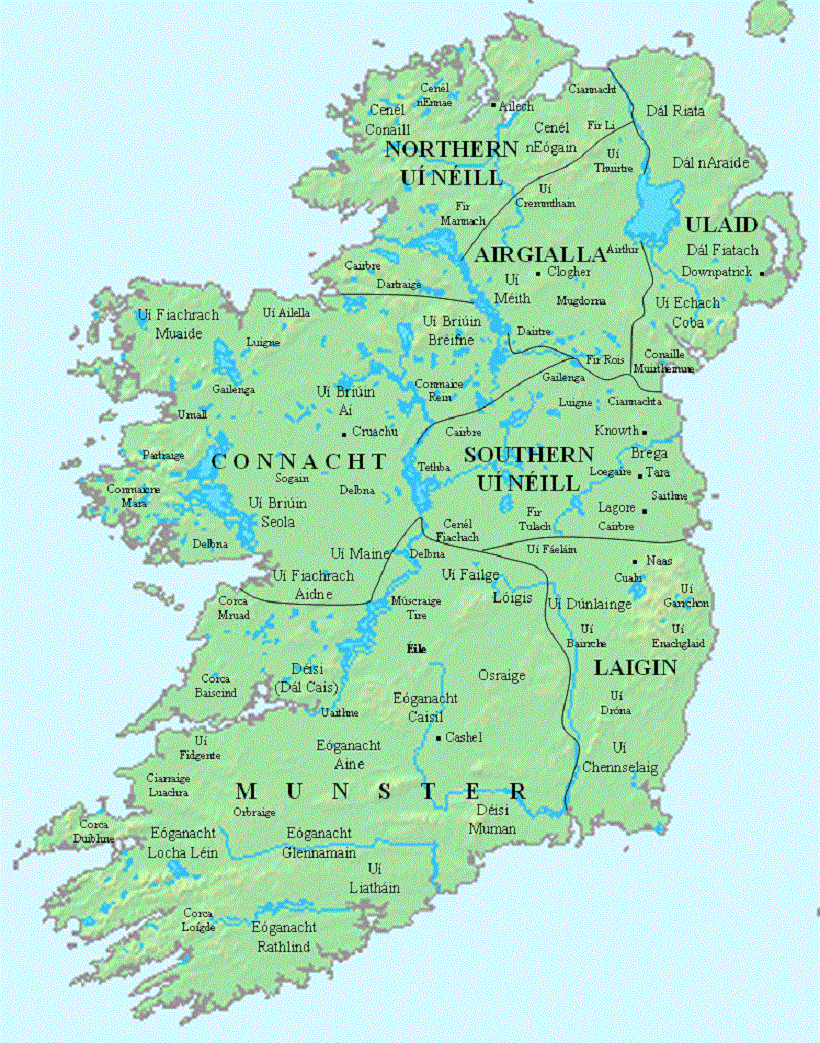
Oriel/Airgialla, 11th century
The struggle of the Irish against the British continued up to and beyond
our Patrick's birth, of course. He was born in the wake of Oliver
Cromwell's conquering of Ireland, when Catholics who didn't even fight
against him had their land taken away. I expect it's most likely that our
McAtee line had been well-settled in Monaghan (or Armagh) when they were
planted. Our line was likely involved in the Irish Rebellion of 1641 and
were expelled to Longford in 1652. They probably had been of an at least
relatively high class. But Longford itself was planted in 1602, so they
didn't exactly escape trouble. But coming to Longford brought them into
contact with the Calverts, and that got them inside knowledge about a 1674
ship going to Maryland, which Patrick and Edmund made their way onto. I
don't know this as fact, but it fits with the evidence. And on the issue
of English subjugation of the Irish, I wonder when our McAtees stopped
speaking Gaelic. It's possible that Patrick still knew Gaelic when he emigrated.
We've now reached the point where documentary evidence has run out. But
thanks to science, we can use DNA to know at least generally the path our
male lines took through human history and what events they may have been a
party to. If you've read the story of my Scott line, its Y-DNA took us on
quite an unexpected journey. I've discovered with my McAtees being part
of the R branch, which is the European one, it's subdivided with good
granularity, allowing a concise tracking of how it got to Europe and
Ireland. So, off we go.
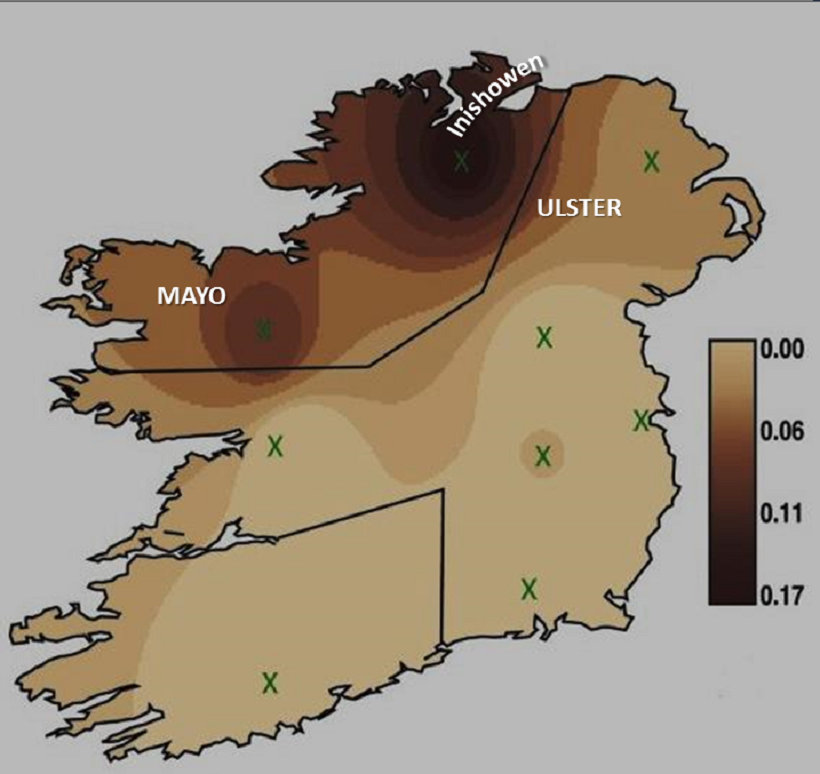
R-M222 distribution
The exact origin of R-M222 overlaps with the northwestern extent of the
over-kingdom of Airgialla. Some historical reason led to a migration
affinity of R-M222 men to the Mayo region, but everywhere else looks like
fairly random diffusion, including to Airgialla. As I noted about R-M222
previously, scholarship on it has shifted from an origin of about 500AD to
potentially many thousand years BC. It's a thoroughly Irish haplogroup,
yet many migrated eastward from 500AD to 1100 and had a lot to do with the
origin of the Kingdom of Scotland. But since our McAtees were Catholic
when they came to America, that suggests the male line never settled in
Scotland. They might've visited. They might've fought overseas. But
they were Irish.
Ancient History
We come now to evidence that northern Europeans didn't actually invent
civilization, and why most of them were called Barbarians by the Romans.
While my Scott line traces through major Middle Eastern civilizations back
to the advent of farming, before my McAtee line entered Ireland they were
part of cultures that didn't have writing to leave a record of their
exploits. But thanks to archaelogists and linguists, we know a bit
about them and can tell a story.
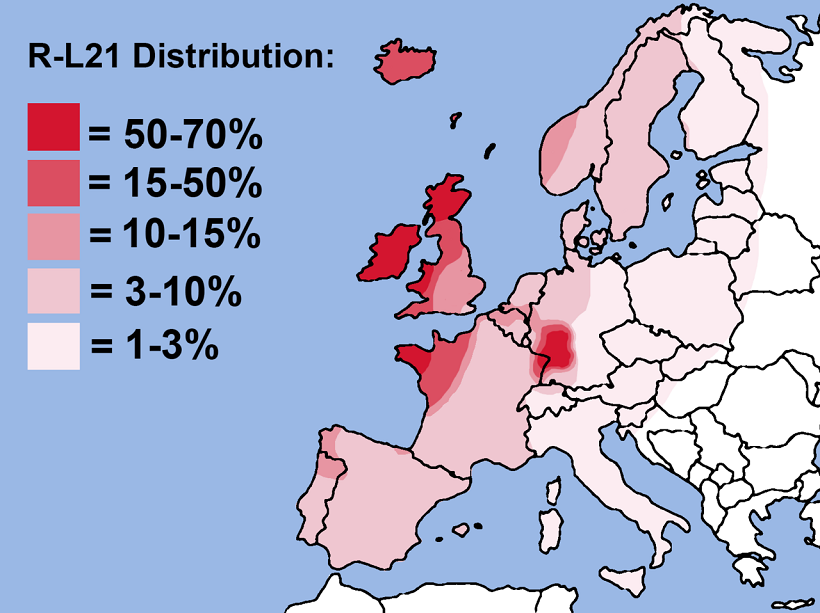
Haplogroup R-M222 is also called R1b1a1a2a1a2c1. The nomenclature is a
little ridiculous, but it shows how many stages have been identified from
R1 to R-M222. What's more ridiculous actually is that only the European
haplogroups have thus far gotten this much attention. So come on,
non-European geneticists. Get busy mapping your branches! I won't dig
into every one of these stages to R-M222, but our line was in the area of
modern Bohemia when they became Celtic, about 5000 years ago. They were
associated with the Corded Ware culture there, and about 500 years later
were associated with the Beaker culture in modern Germany (this is
haplogroup R-L21 mapped above). At some point between then and 500AD,
they came to Ireland.
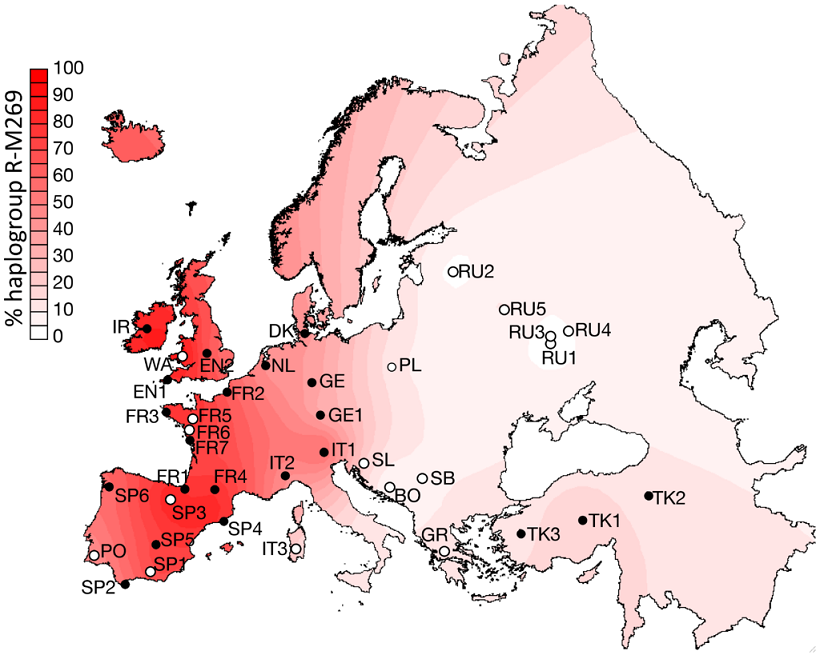
About 8000 years ago, our predecessors of the Celts were associated with
the Yamnaya culture north of the Black Sea. Yamnaya is believed based on
the Kurgan hypothesis to have been the birthplace of Indo-European
culture, meaning that it spread west to Europe and east to India, and
their language was the predecessor of tongues from Sanskrit to Gaelic.
Farming probably came into our line about the same time. Ironically, our
predecessors of the Yamnaya actually came from the Caucasus 10,000 years
ago, so there would be some later backtracking by Indo-European
descendants. But not our line. Ours came from the R-M269 haplogroup,
which moved west to predominantly form a latitudinal band from Barcelona
to Dublin. See the map above. R-M269 is the Brittonic haplogroup. 92%
of modern Welsh men have it, representing the makeup of Celtic tribes all
over Britain and Ireland when the Romans arrived.
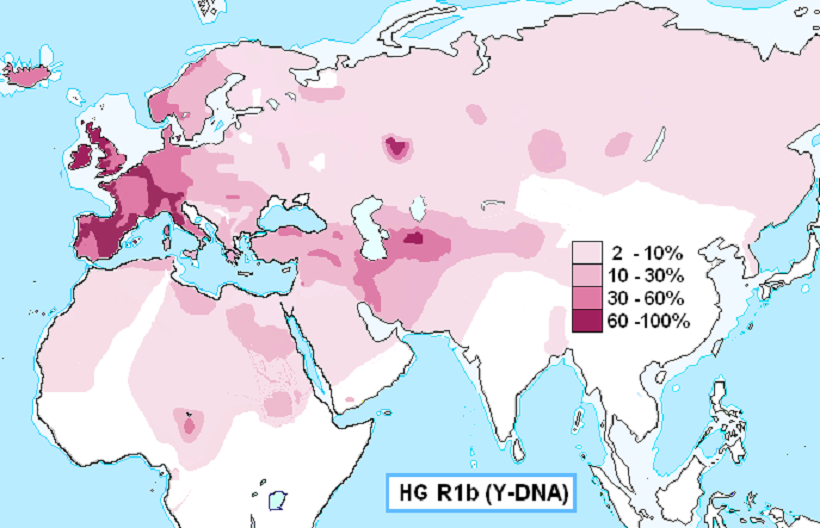
Haplogroup R1b itself emerged about 20,000 years ago, east of the Caspian
Sea. R1b is the predominant Y-DNA of western Europeans, and R1a is that
of eastern Europeans and Russians. R1b men mostly went around the south
end of the Caspian and spread west. R1a mostly went north and spread
north, east, and west.
You've probably noticed about the R haplogroup that the earlier
you go, it didn't come to Europe from Africa, but the East. The reason
for this as I understand it, was that Russia and Europe were under a
giant glacier before the R-haplogroup mutation occurred, so the land to
spread into from Africa was the East. Or
the southern coast into Australasia. I found a really excellent map
that shows Y-DNA migrations and descendence:
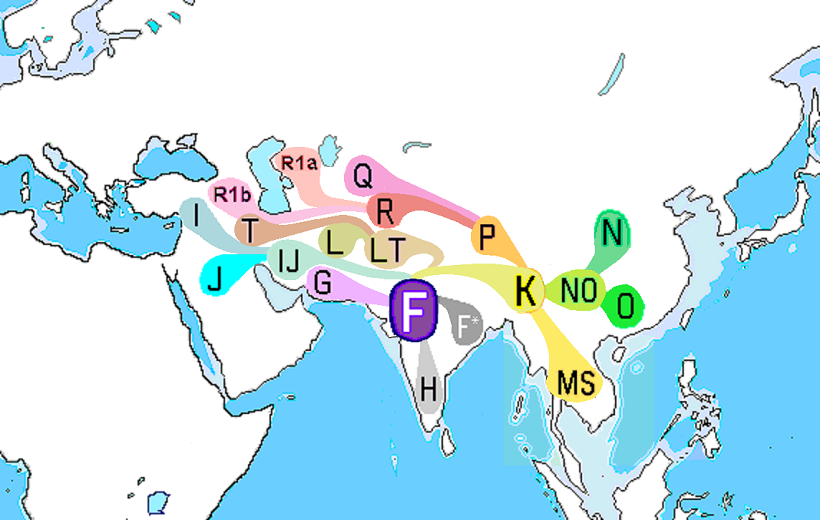
This tells a pretty amazing story in my opinion. My own Y-DNA is J2.
When I wrote up my Scott history, I didn't look earlier than the Middle
East, but I assumed that J came there directly from Africa. This map
shows J being in Arabia, but that's specifically J1. J2 went to around
where I is sitting on this map. But J got there from what's now Delhi
India. Every haplogroup on this map came from there. 90% of men in the
world today descend from haplogroup F. It was C that went to Australasia
and other islands, which isn't shown on this map. But notice the path
of our R-M222 forefathers. As F, they crossed Arabia to come to South
Asia. From there, K emerged and went to the modern Bangladesh area. It
looks like the glaciers began to recede about the time that P emerged
and set our line on its destiny with Europe, proceeding to R and R1b.
It's quite extraordinary. And that's the full story of our McAtee line.
George C McAtee's other Great-Great-Grandparent Lines
In the last phase of this document, I collect all that I know about the non-McAtee paternal lines of the great-great-grandparents of my great-great-grandfather, George C McAtee. Refer to the McAtee Pedigree page for a simple view of George's ancestors.
Hunter
George C McAtee's mother was Sarah Hunter. Sarah was born in the Saline
township of Sevier County Arkansas in 1838. Saline still exists and is
about 12 miles east of De Queen. Sarah wed George B McAtee and moved to
the Sulphur Spring township of Polk County to raise their family. Sarah
wed Silas Jacobs after George B died in the Civil War and Silas raised
George C, still in Sulphur Spring until the late 1880s. Sarah's father
was Nicholas Hunter, born 1816 in Clarksville of Montgomery County
Tennessee. Clarksville is northwest of Nashville, on the Kentucky
border. Nicholas came as a toddler to the Arkansas territory, to the
south of Saline township in what was Hempstead County at the time.
Nicholas's father was Hardy Hunter. The Hunters were slaveholders.
Nicholas owned nine in 1860, and Hardy owned twelve in 1830. Hardy was
born 1777 in Kenansville, Duplin County North Carolina. This is quite
far east in the state, yet Hardy was in Wilson County Tennessee where he
wed in 1811, just east of Nashville. Hardy evidently bore some
similarity to William McAtee, as he was 34 at his marriage. I know
nothing at all about his life before then. Given that he ended up in
central Tennessee, he may very well have been a Kaintuck. But he did
settle down in 1811, and he moved to Montgomery County to raise his
family. Or, to begin to anyway. Surely he was aware of the summons for
volunteers in the Creek War in 1812. But evidently he chose not to, as
child births are attributed to him every two years in Clarksville from
1812 to 1818.
Hardy was then on the move with his young family, coming to the Arkansas
Territory about 1820. He settled in Hempstead County, which had been
formed in 1818. This would be interesting enough, being such an early
immigrant, but much mythology surrounds the research on him before I got
involved. The primary claim about Hardy is that he was nicknamed Horse,
and he was a signficant part Cherokee. I'm quite certain this is a
complete invention, possibly spurred on by the typical tradition of the
"full-blooded Cherokee" grandmother amongst his ancestors. There was a
man who was of similar age to Hardy who was named Horse Hunter, who
lived in Mississippi. Genealogical articles have been written about
Horse. I don't think there's any reason to believe he's the same man
as our Hardy. There may very well be a Native woman in the Hunter tree,
but I've not found anything conclusive, and she would've been outside
George C McAtee's great-great-grandparents.
Another claim about Hardy that I've previously dismissed is that he was
in what would be the Arkansas Territory in 1804, in the same area where
he brought his family in 1820. I used to assume that he couldn't have
been there before he was married, but it may be that this explains what
he was up to from 1797 when he was 20 years old, until 1811. Maybe he
was a 26-year-old in 1803 looking for what to do with his life, when the
Louisiana Purchase happened, and he decided to move into this new
American territory. The 1804 claim was published in an article that also
claimed he was Horse Hunter. It said that Hardy was indeed a river
trader and went to what would become Hempstead County up the Red River
from New Orleans. He was the only white man there in 1804, and he built
a cabin on Beard Lake. Whether or not he was there that early, Beard
Lake was where he came to in 1820.
There's a place called Beard Lake today that isn't a lake at all.
It's at the south end of Millwood Lake, southeast of Ben Lomond. I'm
certain this zeroes-in on where our Hunters lived. I suppose earlier
researchers knew the story of Beard Lake, but I haven't found any
explanation for why the southeastern shore of Millwood Lake has that
name. What I do know is Millwood lake was formed in 1966. Its source
is the Little River, which is a significant feeder of the Red River,
joining it at Fulton Arkansas. A dam was built for controlling
flooding on the Red River. But obviously it didn't exist when Hardy
Hunter moved there, or when he died there in 1856. My guess is that
a natural lake existed at what is now the southeastern part of
Millwood Lake, it was called Beard Lake, and it was subsumed in the new
lake.
Hardy's father was Nicholas Hunter. I'll refer to him as Nicholas the
elder. He was born in Edenton, Duplin County North Carolina. There is
conflicting information on the year, one being 1730 and the other 1745.
Either is possible, as far as I know, but he's claimed to have been a Revolutionary
soldier, and therefore the latter seems more likely. He also died in
Duplin, in 1791. If the latter birth year was accurate, he was only
46 years old. Either way, Hardy was 14 when he lost his father. That
might explain his own wanderlust, and he probably had to grow up early.
The name I have for Nicholas the Elder's mother is Sabra Starkey.
She's been claimed to be the Cherokee source in the Hunter line. I
haven't researched her, but I doubt that she was any kind of Native
American.
The Hunter line gets fuzzy going backward, but it seems that Nicholas
the Elder's father was Job, born 1710 in Nasemond County Virginia. The
line is known to have gone first to Onslow County in North Carolina on
the Atlantic coast, and some have placed Job's birth there. But Onslow
wasn't founded until 1734 and the area wasn't even settled in 1710.
This was evidently a very early North Carolina family, which means they
had means. Job's father was Nicholas Hunter, the first of three with
that name in our line. Nicholas moved the line to Onslow and died
there. He was born about 1680 in New Kent County Virginia. Nicholas's
father was William Hunter, born about 1650 in Alnwick, Northumberland
England.
I've not seen any information on the religion of the Hunters, but I
assume they were Anglican. Male descendants of the line have been
tested as Y-DNA haplogroup R-L2, which is fairly unique and interesting.
This is a branch off R-M269, and specifically from R-S28. Look at the
map below.
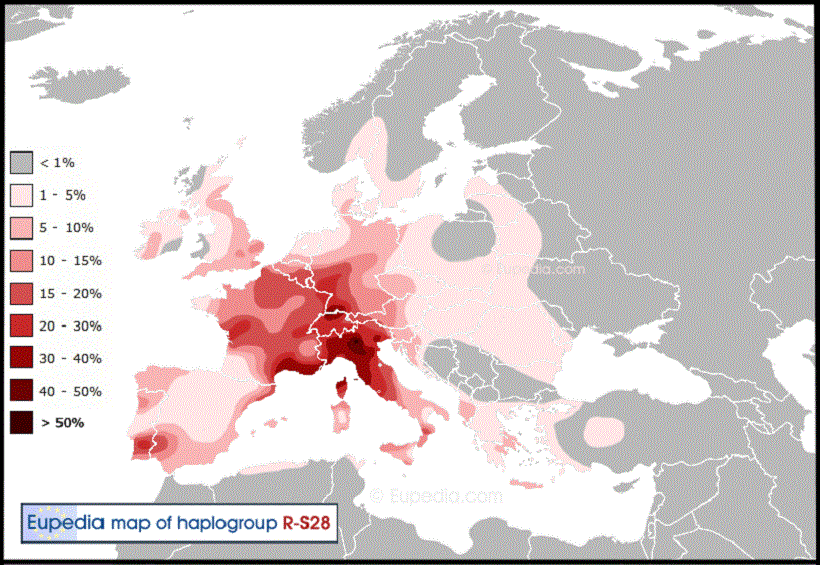
R-S28 is associated with the Hallstatt culture from the Alps that
existed around 1000BC. It's possible that our Hunter line went even
before then to Britain. A wave of R-L2 migrated from the mainland there
around 500BC. But the epicenter of R-S28 opens a possible Roman connection.
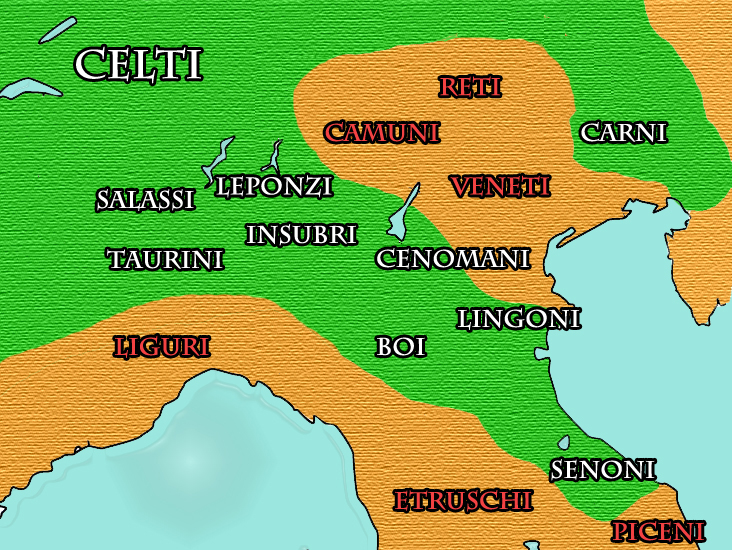
R-L2 seems to originate from the area of modern Milan Italy, which was
settled by a Hallstatt-related culture called the Insubri around 400BC.
See the map above of tribes of the region in 222BC, when the Insubri
were absorbed into the Roman Empire. The Romans named the Insubri home
base Mediolanum, from which the name Milan comes. This said, I've seen
that Hunter is one known surname of what's called the Scoto-Normans,
lines that came from the mainland after 1066. Given our line's coming to
America from the north of England, this may be the most likely origin.
Brown
George B McAtee's mother was Harriet Brown. She was born 1797 in
Montgomery County Virginia, on the Wagon Road. Much of Harriet's story
is told earlier in this document. Her father was Cornelius Brown, born
1759 in Lexington, Rockbridge Virginia. Lexington is just up the Wagon
Road from Blacksburg, which is in Montgomery County and probably where
Cornelius moved to raise his own family. Cornelius made a large move
when he was in his 50s, going to what would become Hempstead County of
the Arkansas Territory in 1820. Harriet was a teenager at the time,
and she later became the second wife of Claiborne Wright and moved
farther to the west on the Red River.
It seems clear that Cornelius's father was Abraham Brown, and Abraham's
father was also named Abraham. Sr was born in 1702 and Jr in 1730. It
also seems clear that the line immigrated directly from Scotland.
What's not clear is where in Scotland, and exactly when. Abraham Jr's
birth is claimed by other researchers to have been in Virginia, on the
Wagon Road. This doesn't make sense for 1730. The typical pattern
I've seen for Scot immigrants is they first came to Pennsylvania, which
fits for the Browns as they were on the Wagon Road in Virginia. Abraham
Sr came in the 1720s. I assume Jr was born in Pennsylvania and moved
to Rockbridge Virginia to raise his own family. But note that the Clarks
of George C's tree came straight from Scotland to North Carolina. Also
of note is Abraham Jr is a common ancestor of both my parents, being in
the Howell tree of my dad's side.
Cornelius was 17 years old in 1776, and I assume he was a Revolutionary
War soldier, but I've found no record of it. He didn't have children
until well after the War, and he was 12 years the senior of his wife.
It's possible that he was adventurous like Hardy Hunter and William
McAtee and traveled widely before settling down. Harriet became a
slaveholder as Claiborne Wright's wife, but I've found no information
on the Brown line before her. Referencing the Clarks again, who followed a similar
pattern, my assumption is the Browns were slaveholders and probably
weren't Presbyterian.
In researching the Y-DNA of the Brown line, I confirmed just how diverse
this surname is. It comes from all over the British isles, and mainland
Europe as well. In the several pages of the Brown DNA Project at
Family Tree DNA, I found only one entry for our line, and that male
descendant was tested as haplogroup J-Z489. This is a branch from J-M67,
which is the same as my own Y-chromosome. I guess the man who took the
test had the best that money could buy, being identified many branches
more specifically than mine. But I've not been able to learn anything
from it. It looks like the Browns were another J2 border clan. They
may even have been Ulster Scots. See the Scott page for my analysis of
how J2 came to the Borders.
Hudgens
Polly Hudgens was Sarah Hunter's mother. Polly was born 1817 in Laurens
County South Carolina. Her father was Ambrose Hudgens, born 1790 in
Newberry County South Carolina. Ambrose fought in the War of 1812 from
South Carolina, presumably in the Creek War. Ambrose moved the family
to Hempstead County Arkansas by 1820, and later moved to Sevier County
where Polly wed Nicholas Hunter. Ambrose Hudgens was the third in the
line of that name, so we'll call him III and his father Ambrose II.
Ambrose II was born 1762 in Goochland County Virginia. He moved to
South Carolina to be wed in 1783. An Ambrose Hudgens fought in the
Revolutionary War, who appears to have been Ambrose I.
Ambrose I was born 1728 in Gloucester County Virginia. Ambrose I served
under Nathanael Greene, who went south to put together a command in the
southern theater. I don't know if Ambrose I was still in Virginia at
that time, but he ended up not only fighting in South Carolina but
living there. He probably had already moved to the Edgefield area. The
line was in New Kent County Virginia in the 1750s. It may be that
Ambrose I wed there and moved on to Goochland. Ambrose I's father
was William Hudgins, who was born 1701 in Llandaff, Monmouthshire Wales.
He immigrated to Gloucester County Virginia by 1728. Our Hudgens line
were slaveholders. I suppose their religion was Anglican. I haven't
been able to find a Y-DNA descendant test, but they were very likely of
haplogroup R-M269.
Clements
Previous research, maybe done by Mary Donnelly, had Rebecca as the name
of William McAtee's mother, but with no maiden name. I thought for a
long time that I'd never discover more about her, which was a significant
hole in the McAtee tree. But after long use of ancestry.com's feature
ThruLines, I realized that I could make an educated guess about the
identity of a person in my tree and ThruLines would confirm it, if
accurate. This methodology is uncertain (as far as I can tell) at the
5th great grandparent of the person tested, but is conclusive at 4th
great grandparent because it can find cousin connections through siblings
of the ancestor.
In this case, my educated guess was that the McAtees were known to have
been neighbors with the Clementses. With that lead, I searched for
Clements men who were peers of Thomas I McAtee and could've had a
daughter Rebecca of the correct age and place. I used the 1800 Charles
County census to confirm this. And sure enough, I found
Samuel Clements born 1721 in Charles County Maryland. I therefore set
William McAtee's mother as Rebecca Clements born about 1770 in Charles
County, and her father as the described Samuel. ThruLines reports 11
connections to Samuel, which is a solid amount for a 5th great grandparent,
and finds cousin connections through Benedict Clements, Samuel's son.
John Clements seems to have been the patriarch of the line in Maryland.
He was born 1647 in Clopton, Middlesex England. Our Samuel may have been
his grandson. It is clear that they were Catholic, at least while they
were in Maryland. I assume they were slaveholders. The surname is Latin
in origin, which probably means that it came to England with the Normans.
Of curious note is that Mark Twain's birth name was Samuel Clemens. Given
the slight difference is surname form, the shared name Samuel might simply
be a coincidence. But I've seen similar transformations when a line went
to the South. They could've been related, especially if Twain's line
came from Maryland. Descendants of John have been tested as Y-DNA
haplogroup E-M35. See the Hollis document, a line that has this very
curious DNA for English people, for my theory on where it came from.
Rowland
Jane Rowland was Harriet Brown's mother. Jane was born in Fincastle, Botetourt County Virginia in 1771. Jane's father was James Rowland, born 1737 in Augusta County Virginia. James was a soldier in Captain Robinson's militia company of Botetourt in the Revolutionary War. James's father was Robert Rowland, born 1716 in Dinwiddie County Virginia. Robert's father was Christopher Rowland, born 1680 in Surry County Virginia. Christopher's father was William, born 1656 in James City County Virginia. William's father was also named William, born 1636 in James City. William Sr's father was John, born 1614 in Egham, Surry England. John went to Bermuda as a young man. That apparently didn't work out, as he went on to Jamestown. Jamestown was fairly well-established by then, and post-massacre. This is a tangential connection to Jamestown. Presumably the Rowlands were Anglican. This line is too early to have records of them being slaveholders. I'm assuming they weren't. The surname is Norman in origin. A descendant of Robert was tested as Y-DNA haplogroup R-M269.
Clark
Hardy Hunter's wife was Elizabeth Clark. The Clarks were a prominent early
family of the Red River area. In fact, unless Hardy did go to Arkansas
before 1810, before he got married, it looks like the Hunters came to
Arkansas with the Clarks. Elizabeth was born 1794 in Duplin County North
Carolina. Remember that Hardy Hunter was born there in 1777. Elizabeth's
father was Benjamin Clark, born 1758 in Dobbs County southeast of Raleigh.
Dobbs ceased to exist in 1791. A researcher of the line claims that
Benjamin went to the Nashville Tennessee area by 1799 and operated Clark's
Ferry on the Cumberland River. Elizabeth wed Hardy in Wilson County east
of Nashville in 1811. Unless Hardy's son Nicholas was actually born in
Arkansas, Benjamin Clark moved to the Red River area before Hardy, which was
in 1814. Elizabeth's brother Benjamin was a prominent man in the area.
Clarksville Texas was named after him. Benjamin Sr's father was also named
Benjamin, so I'll refer to him as
Benjamin II. The original courthouse of Washington Arkansas was on Benjamin
II's land. I've not done much research on Benjamin II, but I'm certain
there's much to learn. He moved to Jonesboro in future Texas in 1826, and
died 1838 in the Texas Republic.

Original Washington Arkansas courthouse - became capitol of Arkansas during the Civil War
Benjamin II fought in the Revolutionary War as part of the North Carolina
militia, including the Battle of Cape Fear. He wed 1782 in Granville
County. Benjamin I was born 1724 in Jura, Argyll Scotland. Wikitree.com
traces the line several generations back in Jura. The Clarks were
slaveholders. I assume that they weren't Presbyterian, as that sect was
opposed to slavery. I've found no clear Y-DNA connection to the Benjamins,
and the Clark/Clarke surname comes from many sources, so my guess is
haplogroup R-M269, which is most common.
Pennington
Martha Pennington was Sarah Hunter's maternal grandmother. Martha was born
in 1793. She claimed it was in Georgia in the 1850 census, and Kentucky in
1860. Her children were born in South Carolina, and an eastward move at
that time, even just a few hundred miles, was very unlikely. Therefore I
believe she was born in Laurens County South Carolina, but it's possible
that her children were born in Georgia and her husband came west to her
from Laurens. Martha's father was
William Pennington, born 1770 in Guilford County North Carolina. Both
ended up in Arkansas, but my assumption is that William first moved to
South Carolina to raise his family. I have found Penningtons in Georgia
who very likely were related, so I expect that Martha did live in Georgia
at some point as a child. It seems unlikely that she ever went to
Kentucky, as her father was in Union County Arkansas in 1830, and she went
on to Howard County. Her husband Ambrose Hudgens also claimed to have
been in Kentucky, and equally seemed unlikely. My guess is this was a fib
related to the Civil War, maybe taking a pro-Union stance.
Information on the entirety of this line is iffy, and ThruLines ceases to
help trace backward from William. A line of Ephraim Penningtons seem to
be the origin of the line. My guess is that Levi born 1725 in Rowan County
was William's father. He had a brother named Ephraim. Levi's father was
Ephraim born 1689 in Morristown, Middlesex New Jersey. His father was
Ephraim born 1668 in Newark, Essex New Jersey. His father was Ephraim born
1645 in New Haven Connecticut. Connecticut is definitely an unusual origin
for one of our lines, but I read that Newark was founded by a group from
New Haven. I guess our line was part of that. The immigrant was Ephraim
Pennington born 1620 in Muncaster, Cumberland England. Wikitree.com traces
the line a few more generations back, to Lancashire. The Penningtons were
slaveholders, possessing ten in 1830. Presumably they were Anglican. I've
found no military service in the line. Descendants of the Ephraims have
been tested as Y-DNA haplogroup R-DF63, which is a subgroup of R-L21, which
comes from R-M269. For an English line, it most probably came with the
Normans. But it's also common in the western British Isles, and Lancashire
is on the west coast of England between Wales and Scotland.

Dyer
The name I have for Thomas II McAtee's mother is Ann Dyer. I believe this is correct, but though ThruLines reports matches for her, it can't make connections to her parents via siblings. It appears that Ann's mother was Ann Thomas, and I have Ann Thomas Dyer as the younger's full name. I found only one prospective father for Ann, who was Patrick Dyer born 1680 in Maryland. Ann was probably born in Prince George's County and moved to Charles County to wed Thomas McAtee. I saw a Jeremy Dyer born 1655 who was probably Patrick's father, but there's no info on where he came from. The form of the surname is English for someone who worked with dyes, but it could also have been anglicized from a Gaelic name (O'Dwyer?). Given the name Patrick, that they were in early Maryland, and they wed into a Catholic family, they must've been Catholic. So their origin was either Catholic English or native Irish. Y-DNA could be used to help, but though there is a Dyer DNA project, our connection to the line is so early that I found no connection. Without more info, I'm assuming this was a native Irish line from Longford with Y-DNA haplogroup R-M269. Going with the idea of them being similar to the McAtees, my guess is they were not slaveholders initially.
Greene
When I entered Samuel Clements as Thomas II McAtee's father-in-law, all that was suggested about Samuel's wife was that her first name was Margaret. She was my mom's 5th-great grandparent, so ThruLines can't help to prove who her parents were. It can't make connections through her siblings. I made a guess here that her maiden name was Greene, given other connections to Greenes amongst the McAtees, related to the former governor of Maryland. ThruLines returns double-digit matches for Margaret Greene. It doesn't show what that's based on, so all I can do is believe she was an ancestor. Her prospective father was Giles Greene, born about 1700 in Port Tobacco. I know nothing else about this line, but houseofnames.com says it has a deep connection with Kent England. We have the Green surname in the Hollis tree, but they were from Virginia and not Maryland, so any relation was before America. Presumably the Maryland Greenes were Catholic. I found no connection in the Green DNA project, so the best I can guess for Y-DNA haplogroup is R-M269. I presume they were not slaveholders.
Kirkham
Margaret Kirkham was Abraham Brown's wife, and thus also a common ancestor of both my parents. The Brown line was uncertain, and the Kirkham line is even less certain. Margaret was born in 1745. Her father was Robert Kirkham, born 1699 in Augusta County Virginia according to Geni.com. Geni then has James as Robert's father, but with James living all his life in Maryland. My guess is that Robert moved to Augusta and Margaret was born there, but Robert was born in Queen Anne's County Maryland. James was born 1680 in Talbot County. James's father was William, who immigrated to Talbot from England, where he was born in 1655. The town of Kirkham in Lancashire is the origin of the name. I don't know where in England William was born, so I'll place it in Kirkham. I have no information that the Kirkhams were slaveholders. Presumably they were Anglican. There is no Kirkham DNA project, so I have to default guess Y-DNA haplogroup R-M269. I've seen a claim that the line came to Maryland via Ulster, but there seems little time for it if the immigrant came by 1680.
Kyle
Harriet Brown's maternal grandmother was Margaret Kyle. Margaret was born 1741 in Buckingham, Albemarle County Virginia. Margaret's father was Robert Kyle, born 1702 in County Tyrone Ireland. I have no other specifics on this line, but it is Scots-Irish originally from Cumnock Ayrshire. It quite likely had roots in the kingdom of Stratchclyde. Though the line was Scottish, they didn't follow the Presbyterian path, and I assume they were Anglican. I have no evidence that they were slaveholders. I found no connection in the Kyle DNA project, but it's likely they were Y-DNA haplogroup R-M269.
Buchanan
Hardy Hunter's mother was Susannah Buchanan. Susannah was born 1760, probably in North Carolina. She wed Nicholas Hunter 1777 in Chowan County, and they moved to Duplin. The only thing clearly known about the Buchanans is that they come ultimately from Stirlingshire Scotland. Certainly Susannah lived in Chowan, which is in the far northeast of North Carolina. This means that her father came from someplace farther north, or directly from Scotland. There was a James Buchanan born 1715 in Scotland, who went to North Carolina. There was a James Buchanan born 1734 in Charles County Maryland, who went to North Carolina. There was a William Buchanan born 1735 in Lancaster County Pennsylvania, who went to North Carolina. Given the pattern of other Scottish lines in George C McAtee's tree, I would lean away from Pennsylvania and toward direct immigration from Scotland. I would also guess that the line was Anglican, not Presbyterian. I have no evidence that they were slaveholders. I found no clear connection in the Buchanan DNA project, but the line likely was Y-DNA haplopgroup R-M269.
McClendon
Mary McClendon was Benjamin Clark's wife. ThruLines reports triple-digit connections to Mary, but it can't show connections through her siblings to tell who her parents were. This line is unusually clear for its early origin in George C McAtee's tree. Mary was born 1775 in Duplin County North Carolina. Mary's father was Jesse McClendon, born 1745 in Craven County. Jesse's father was Dennis McClendon, born 1718 in Perquimans County. Dennis was a lawyer. Dennis's father was Thomas McClendon, born 1690 in Logan, Ross-shire, Scotland. Houseofnames.com insists that the McClendons are Irish in origin, a sept of the kingdom of Oriel like the McAtees. Ross-shire is in the highlands, so it seems that the McClendons were part of the kingdom of Dal Riata founded by Irish immigrants in the 6th century. I would guess this line was Anglican, and I have no evidence of slaveholding. Descendants of Dennis McClendon have been tested as Y-DNA haplogroup R-M269.
Henderson
Ambrose III Hudgens's mother was Elizabeth Henderson. Elizabeth was born 1763 in Granville County North Carolina. I have Henderson ancestors on my dad's side, but any relation between the two lines was a long time ago. While the Scott side was Presbyterian, this one like other Scottish lines in George C McAtee's tree, seems to have been Anglican with a long history in Virginia. Elizabeth's father was James Henderson, born 1740 in Hanover County Virginia. James's father was Richard born 1696, I believe in Henrico County. Richard's father was also named Richard, born 1676 in New Kent County. Richard Sr's father was Thomas, born 1653 in New Kent. Thomas's father was Robert, born 1626 in Fife Scotland. I have no direct evidence that these Hendersons were slaveholders, but I believe they were. Elizabeth's father ended up in Laurens South Carolina, a hotbed of plantations. These Hendersons were Y-DNA haplogroup R-M269.
Warren
Polly Hudgens's maternal grandmother was Agnes Warren. ThruLines can't make connections to Agnes's siblings, but it returns almost a hundred matches anyway. This apparent certainty isn't aided by the documentary record, but there were several Warren lines that went to North Carolina. Warren is an English surname that ultimately traces to Varrenne in Normandy. Agnes was born 1770, probably in North Carolina. Her husband was born the same year in Guilford County. A Jacob Warren born 1740 came from a line that were early immigrants to North Carolina. They didn't tend to associate with Guilford, so I would lean against him as being Agnes's father. A Daniel Warren born 1729 had a similar origin. A Goodloe Warren born 1738 in Spotsylvania County Virginia was one of three brothers who went to North Carolina. Their line traces back to Old Rappahannock County immigration in 1635. A Hinchley Warren born 1727 in Surry County Virginia came from a line that immigrated from Kent in 1645. I don't know which of these latter two to lean toward. The Rappahannock Warrens were Y-DNA haplogroup R-M269, and the Surry line was I-M253. I presume ours were Anglican, and I have no evidence that they were slaveholders.
Summary of George C McAtee's Great-Great-Grandparent Lines
Nine of the sixteen lines were known to have been slaveholders, or were
likely to have been. It's entirely possible that all sixteen were, but
most lived too long ago to leave records. Though George C McAtee came
from an Irish line, seven of his great-great-grandparent lines were
English and six were Scottish. Though Scotland was a Presbyterian
country, there were Episcopalians, and the pattern of immigration of all
of these in this tree was aligned with Anglicans. Five of the English
lines were Anglican, as was the one Welsh line. The two Irish lines
were Catholic, as well as two of the English. Genetically the Y-DNA
haplopgroup R-M269 accounts for at least two thirds of George C McAtee's
ancestors, but keep in mind that this is the default guess when the
haplogroup isn't known for a certainty. That said, most were R-M269 as
that was most common. Aside from R-M269, this tree has one each of
R-M222, R-L2, R-L21, J-M67, and E-M35. All but the latter two fall
under the typical western European R1b haplogroup. Only the R-M222
Y-DNA came down to us, but the others do help in understanding where
George C McAtee's ancestors came from.
Migration paths
McAtee: 1910 Vine Prairie, Crawford, Arkansas - 1880 Alma, Crawford, Arkansas - 1845 Sulphur Spring, Polk, Arkansas -
1834 Maine Creek, Hempstead, Arkansas - 1828 Pecan Point, Miller, Arkansas - 1812 Alexandria, Rapides, Louisiana -
1811 Nile, Scioto, Ohio - 1810 Calverton, Montgomery, Maryland - 1679 Pomfret, Charles, Maryland -
1674 St Marys, St Marys, Maryland - 1652 Drumlish, Longford, Ireland - 0 Portadown, Armagh, Ireland
Hunter: 1856 Sulphur Spring, Polk, Arkansas - 1838 Saline, Sevier, Arkansas - 1820 Beard Lake, Hempstead, Arkansas -
1812 Clarksville, Montgomery, Tennessee - 1811 Lebanon, Wilson, Tennessee - 1770 Kenansville, Duplin, North Carolina -
1730 Wantlands Ferry, Onslow, North Carolina - 1675 Suffolk, Nansemond, Virginia - 0 Alnwick, Northumberland, England
Brown: 1815 Washington, Hempstead, Arkansas - 1790 Blacksburg, Montgomery, Virginia - 1755 Lexington, Rockbridge, Virginia -
1725 Newtown, Bucks, Pennsylvania - 0 Edinburgh, Midlothian, Scotland
Hudgens: 1820 Washington, Hempstead, Arkansas - 1780 Newberry, Ninety-Six, South Carolina - 1755 Goochland, Goochland, Virginia -
1725 Gloucester, Gloucester, Virginia - 0 Llandaff, Monmouthshire, Wales
Clements: 1680 Port Tobacco, Charles, Maryland - 0 Clopton, Middlesex, England
Rowland: 1790 Blacksburg, Montgomery, Virginia - 1760 Fincastle, Botetourt, Virginia - 1735 Staunton, Augusta, Virginia -
1710 Dinwiddie, Dinwiddie, Virginia - 1680 Surry, Surry, Virginia - 1625 Jamestown, James City, Virginia -
0 Egham, Surry, England
Clark: 1799 Lebanon, Wilson, Tennessee - 1785 Kenansville, Duplin, North Carolina - 1758 Kinston, Dobbs, North Carolina -
0 Jura, Argyll, Scotland
Pennington: 1790 Laurens, Laurens, South Carolina - 1720 Greensboro, Rowan, North Carolina - 1688 Morristown, Middlesex, New Jersey -
1665 Newark, Essex, New Jersey - 1640 New Haven, New Haven, Connecticut - 1600 Muncaster, Cumberland, England - 0 Blackpool, Lancashire, England
Dyer: 1680 Brandywine, Prince George, Maryland - 0 Longford, Longford, Ireland
Greene: 1695 Port Tobacco, Charles, Maryland - 0 Maidstone, Kent, England
Kirkham: 1740 Staunton, Augusta, Virginia - 1690 Kent Island, Queen Anne, Maryland - 1680 Easton, Talbot, Maryland - 0 Kirkham, Lancashire, England
Kyle: 1730 Buckingham, Albemarle, Virginia - 1680 Tyrone, Tyrone, Ireland - 0 Cumnock, Ayrshire, Scotland
Buchanan: 1770 Edenton, Chowan, North Carolina - 0 Stirling, Stirlingshire, Scotland
McClendon: 1770 Kenansville, Duplin, North Carolina - 1740 New Bern, Craven, North Carolina - 1715 Hertford, Perquimans, North Carolina -
0 Logan, Ross-shire, Scotland
Henderson: 1760 Oxford, Granville, North Carolina - 1740 Ashland, Hanover, Virginia - 1690 Henrico, Henrico, Virginia -
1650 Quinton, New Kent, Virginia - 0 Kirkcaldy, Fife, Scotland
Warren: 1770 Greensboro, Guilford, North Carolina - 1730 New Post, Spotsylvania. Virginia - 1635 Farnham, Old Rappahannock, Virginia -
0 Tonbridge, Kent, England
last edited 1 Nov 2022
